A map of the least-traveled routes in each US state (along with 10 of the most scenic routes)



This site is made possible by member support. 💞
Big thanks to Arcustech for hosting the site and offering amazing tech support.
When you buy through links on kottke.org, I may earn an affiliate commission. Thanks for supporting the site!
kottke.org. home of fine hypertext products since 1998.
Entries for March 2018
Rams, a documentary about legendary designer Dieter Rams
Dieter Rams is one of the world’s most influential designers. Rams acolyte and Apple design chief Jony Ive has said of him:
Dieter Rams’ ability to bring form to a product so that it clearly, concisely and immediately communicates its meaning is remarkable… He remains utterly alone in producing a body of work so consistently beautiful, so right, and so accessible.
Gary Hustwit, director of Helvetica and Objectified, is making a documentary about Rams called Rams. Here are three short clips from the film:
Rams will include in-depth conversations with Dieter, and dive deep into his philosophy, his process, and his inspirations. But one of the most interesting parts of Dieter’s story is that he now looks back on his career with some regret. “If I had to do it over again, I would not want to be a designer,” he’s said. “There are too many unnecessary products in this world.” Dieter has long been an advocate for the ideas of environmental consciousness and long-lasting products. He’s dismayed by today’s unsustainable world of over-consumption, where “design” has been reduced to a meaningless marketing buzzword.
The movie will have original music by Brian Eno and will be released sometime later this year.
Update: Wallpaper has a trailer for the film, which looks minimalistic af.
Hear Beowulf & Sir Gawain and the Green Knight read in the original Old and Middle English
In this short video, MIT literature professor Arthur Bahr reads brief selections from Beowulf and Sir Gawain and the Green Knight in their original languages, respectively Old English and Middle English. You’ll notice that they sound almost completely like foreign languages. From Open Culture:
After the Viking and Norman invasions, Old English became “the third language in its own country,” notes Luke Mastin at his History of English site. More spoken than written, it “effectively sank to the level of a patois or creole,” with several distinct regional variants. English seemed at one time “in dire peril” of dying out but “showed its resilience once again, and, two hundred years after the Norman Conquest, it was English not French that emerged as the language of England,” though it remained a diffuse collection of dialects.
The entire page on Middle English at the History of English site — “how English went from an obscure German dialect to a global language” — is worth a read.
Meet Doris Jones, a 90-year-old armchair space archaeologist
I don’t know who my old favorite archaeologist was, but my new favorite archaeologist is Doris Jones. Jones is 90 years old and is one of the top volunteer space archaeologists on GlobalXplorer, a site that crowdsources the process of locating potential archaeological sites on satellite imagery. People like Jones look at satellite images for telltale signs of past human activity and promising locations are then passed on to field archaeologists working in the area.
From 2007: “Will MySpace ever lose its monopoly?” The piece mentions two possible competitors, neither of them Facebook or Twitter.
Remember that sculpture of Cristiano Ronaldo that didn’t look very much like him? The amateur sculptor who made it gave it another try…
An AI paints nightmarishly surreal nude paintings


Titian on shrooms? Francis Bacon turned up to 11? Picasso++? Dali, um, well, Dali would probably come up with something like this tbh. Robbie Barrat is a machine learning researcher at Stanford who’s using an AI program to generate nude portraits (more, more, and more).
Usually the machine just paints people as blobs of flesh with tendrils and limbs randomly growing out — I think it’s really surreal. I wonder if that’s how machines see us…
(via boing boing)
Janus words: “words that are their own opposites”. Examples are cleave, clip, and fast, as in “the car is fast” and “the rope held fast”.
Tyler Cowen’s great wide-ranging conversation with Martina Navratilova. “You were a contender, and then you became completely dominant, say, by 1981. How did you do that?”
Fooling online users with dark patterns
From Evan Puschak, a quick video on dark patterns, UI design that tricks users into doing things they might not want to do. For instance, as he shows in the video, the hoops you need to jump through to delete your Amazon account are astounding; it’s buried levels deep in a place no one would ever think to look. This dark pattern is called a roach motel — users check in but they don’t check out. I wonder how much this single pattern has added to Jeff Bezos’ personal net worth?
The world’s smallest sushi is made from a single grain of rice

At Sushiya no Nohachi in Tokyo, you can eat sushi that is made using a single grain of rice. The tiny sushi came about when a customer challenged the owner’s son to make the smallest possible sushi.
The most difficult tiny sushi are the ones with nori seaweed — those are the sea urchin and egg. For sea urchin, he has to put a small piece of nori around a grain of rice horizontally. For egg, he has to wrap the nori around the egg and grain of rice. It’s pretty impressive to witness.
You can see the small sushi being made in this video:
That said, when we asked how often they need to make a plate of small sushi, we were surprised.
“Just a few times a week and at most five times in a day.” Though when customers from overseas order, they tend to be extra enthusiastic about the tiny sushi.
He told us that one woman from Europe burst into tears and cried for an hour and a half after seeing the cute, little sushi.
(thx, jason)
Fake laughs! The invention of the laugh track.
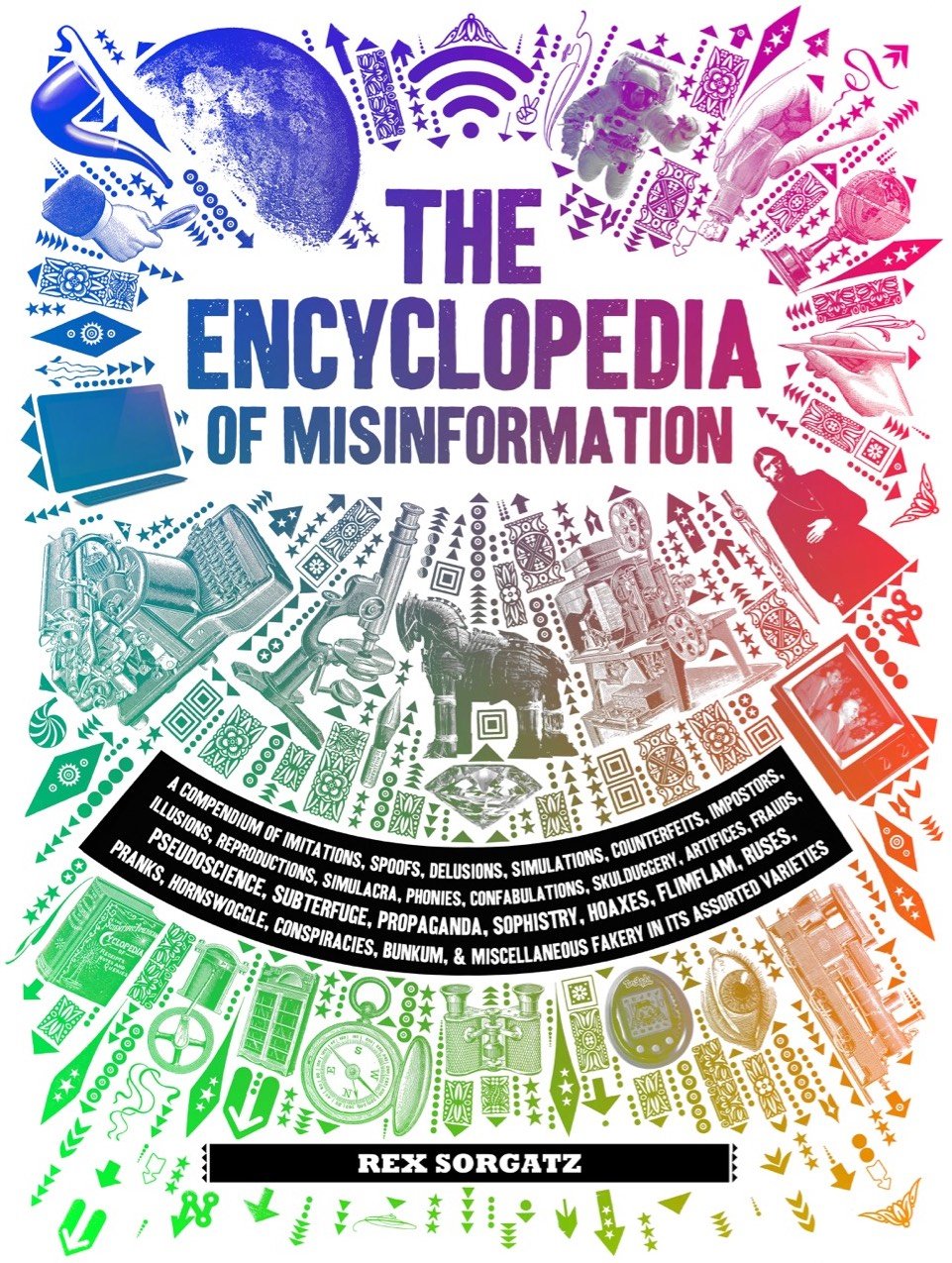
On Tuesday, my friend Rex Sorgatz came out with the very timely book, The Encyclopedia of Misinformation, the full subtitle of which is “A Compendium of Imitations, Spoofs, Delusions, Simulations, Counterfeits, Impostors, Illusions, Confabulations, Skullduggery, Frauds, Pseudoscience, Propaganda, Hoaxes, Flimflam, Pranks, Hornswoggle, Conspiracies & Miscellaneous Fakery”. Today I’m happy to present an excerpt about the genesis and use of the laugh track on television. [The video insert on how the laff box worked is mine.] -jason
No technique in television production has been more maligned than the laugh track, yet it somehow perseveres through decades of ridicule.
It all started innocently, as a quick hack to solve a technical problem. Charley Douglass, a sound engineer at CBS in the early ’50s, was annoyed at studio audiences who inconveniently laughed at the wrong moments. Sometimes they chuckled too long at unfunny bits; other times, they refused to bellow with sufficient gusto. To evenly redistribute the laughter, Douglass invented a contraption that looked like a steampunk organ collided with a cyberpunk adding machine, connected on the back end to magnetic tapes with recorded laughter. By pressing buttons on the laff box (that’s actually what he called it), an orchestrator could punch up guffaws, chortles, and giggles on demand. The magical machine also acted as a sort of demographic keyboard, with inputs for specific genders, ages, and ethnicities, plus a foot pedal that controlled the duration of each laugh. One keystroke might simulate frothy housewife giggle; another, guy who missed joke but laughs anyway. Keys could be combined into melodic chords of laughter, bringing down the house in a crescendo of hilarity.
The gizmo was a success, smoothing out the aural wrinkles in programs like The Abbott and Costello Show and I Love Lucy. It was a necessary evil of this nascent era, when television was rapidly changing from live broadcast to taped recordings. Audiences were still growing accustomed to the big square tube in their living rooms, and the laugh track helped ease the transition by simulating an intimate theater experience at home. You knew when to laugh because they told you when to laugh.
Naturally, this quaint bag of laughs was quickly abused. Sitcoms in the ’60s and ’70s took the laff box and cranked it to eleven. Realizing canned chuckles freed them from the burden of a live audience, shows like Gilligan’s Island and The Brady Bunch ratcheted the laugh track to egregious levels. No show could escape the canned laughter craze — beloved programs like The Muppet Show and M*A*S*H used laugh tracking, even during outdoor scenes, when a studio audience was improbable. When animated shows like The Flintstones and The Jetsons added tracks of artificial mirth, the entire illusion of a captive studio audience was finally shattered.
Show creators hated the laugh track, spurring a constant feud with network executives who believed audiences enjoyed the audio cues. To adjudicate the conflict, CBS held a controlled experiment in 1965 with its brand-new show Hogan’s Heroes. The network tested two versions of the World War II comedy — one with canned laughter, one without. The test audiences overwhelmingly preferred the laugh-tracked show. Since then, nearly all CBS comedies have contained audience laughter.
Fake laughter was far from universal though. Many beloved shows, including The Mary Tyler Moore Show, Friends, Cheers, and Seinfeld, used studio audiences for most of their laughter, only adding dashes of the canned stuff through sweetening (that’s the term of art).1
But laughter of all kinds — live or tracked — was becoming the joke of the sitcom industry, as a morose aura started to envelop the merriment. An oft-told anecdote asserted that due to track age, the laff box contained the chortles of dead people. The canard seems to have originated with Jim Carrey as Andy Kaufman in Man on the Moon (1999), who ad libbed this bit of dialogue about sitcoms like Taxi:
It’s just stupid jokes and canned laughter! And you don’t know why it’s there, but it’s there! And it’s dead people laughing, did you know that? Those people are dead!1
It might have been true in the ’70s, but the claim is likely not accurate today, as audio engineers are known to assiduously update their libraries with new snorts and snickers.
Regardless, the stench of dead laughter was in the air. Starting in the early aughts, shows began to jettison the laugh track, as most celebrated comedies of the era — The Office, Arrested Development, Curb Your Enthusiasm, Orange Is the New Black, 30 Rock, Community, Louie, Modern Family — abandoned the cheesy blandishment. Some programs maintain laugh tracks today (especially those on CBS), and they do tend to get good ratings. In fact, one can almost divide sitcoms into two categories — “critically acclaimed” versus “high ratings” — on whether they use a laugh track. As a generalization, shows that cozen a laugh from the viewer perform better in the ratings but seldom win Emmys.
Although widely derided, the laugh track served its purpose. Television began as a medium for viewing live events with an audience (essentially theater-at-a-distance), and it took decades for television to evolve into its own medium. The laff box allowed producers to literally play the audience, like an organ. Perhaps it was synthetic, but the technical innovation put the audience into the tube, creating a more communal experience in our homes. Today, that role — incorporating a disembodied audience — is played by social media. LOL.
If you’re interested in reading about more simulations, skullduggery, and flimflam, The Encyclopedia Of Misinformation is now available on Amazon.
Sweetening is demonstrated with dismay in Annie Hall when Woody Allen witnesses laugh tracks being added to a live broadcast in a Los Angeles television studio. The term is also invoked in other commercial arts. When Kiss’s Alive! was released in 1975, it claimed to be a live album but many tracks were clearly sweetened, as they say, with studio overdubs to sharpen the sound.↩
Another oft-cited (but inaccurate) source for this old saw is Chuck Palahniuk’s 2002 novel Lullaby: “Most of the laugh tracks on television were recorded in the early 1950s. These days, most of the people you hear laughing are dead.”↩
Advice for visiting Paris
Tyler Cowen has some advice for those looking to visit Paris.
My overall take is this: Paris today is fairly sterile in terms of overall creativity, or for that matter business dynamism. But Parisians have perfected the art of taste along a number of notable dimensions, like nowhere else in the world. If your trip allows you to free ride upon those efforts in a meaningful way, it will go very well.
I am not with him about skipping the Jardin du Luxembourg (it’s one of my favorite places in Paris) and I would urge you to skip not only the Mona Lisa but the entire Louvre (go to d’Orsay instead). But eating cheese (and bread!), developing a “mini-Paris residential life”, going to the top of the Eiffel Tower, seeing the cathedrals, walking everywhere,1 and skipping the expensive restaurants is all solid advice. Further Paris notes from my trip last October here.
I just looked at my Pedometer++ data from my October trip to Paris and during a 7-day period, I averaged 8.5 miles of walking per day.↩
Bill Ewasko disappeared in Joshua Tree National Park eight years ago. He’s still missing and an unofficial search goes on. “People should not be able to disappear, not in this day and age.”
How to Make 29 Different Shapes of Pasta by Hand
Somehow, I happily watched all 26 minutes of this video on how to make 29 different pasta shapes by hand. Pasta architecture is fascinating!
Semolina pasta is a southern Italy specialty. From that dough, Luca makes cavatelli, malloreddus, lorighittas, cencioni, capunti, strascinati, culurgionis, and sagne incannulate. From the egg dough, D’Onofrio makes fusilli al ferretto, tagliatelle, tortellini, farfalle, garganelli, anolini, cappelletti, tagliolini, agnolotti, sacchetti. From the spinach dough, Luca makes foglie d’ulivo, trofie, fagiolini, and pappardelle. From the cuttlefish squid ink pasta dough, D’Onofrio makes orecchiette, strichetti, fettuccine, and corzetti.
(via the kid should see this)
The Preciousness of Time, a tribute to Stephen Hawking
John Boswell, aka melodysheep, created this tribute video for Stephen Hawking using the late physicist’s words drawn from a variety of different speeches and interviews. It begins:
I am very aware of the preciousness of time. I was given two to three years to live. I faced a life unable to properly communicate. Fortunately my mind was unaffected. While all around me people have passed the day deep in conversation, I have often been transported afar, lost inside my own thoughts, trying to fathom how the universe works.
The 13 most Wes Anderson things about Wes Anderson movies
When you’re watching a Wes Anderson movie, you are never not aware that you’re watching a Wes Anderson movie. In this video, ScreenPrism examines the 13 aspects common to most of the director’s films. There’s the art-directed microworlds (the sub in The Life Aquatic, the house on Archer Avenue in Tenenbaums), the distinctive camera language (wide-angle shots, symmetry), the extensive use of musical deep cuts from the 60s and 70s (These Days by Nico in Tenenbaums), performances within the films (the plays in Rushmore, Tenenbaums, and Moonrise Kingdom), the exacting & deadpan dialogue, and children who act like adults and adults who act like children (which Anderson got from Charles Schulz).
If you remember the honest trailer for every Wes Anderson movie from last week, this is the nicer version of that.
Whatever You Do, Don’t.
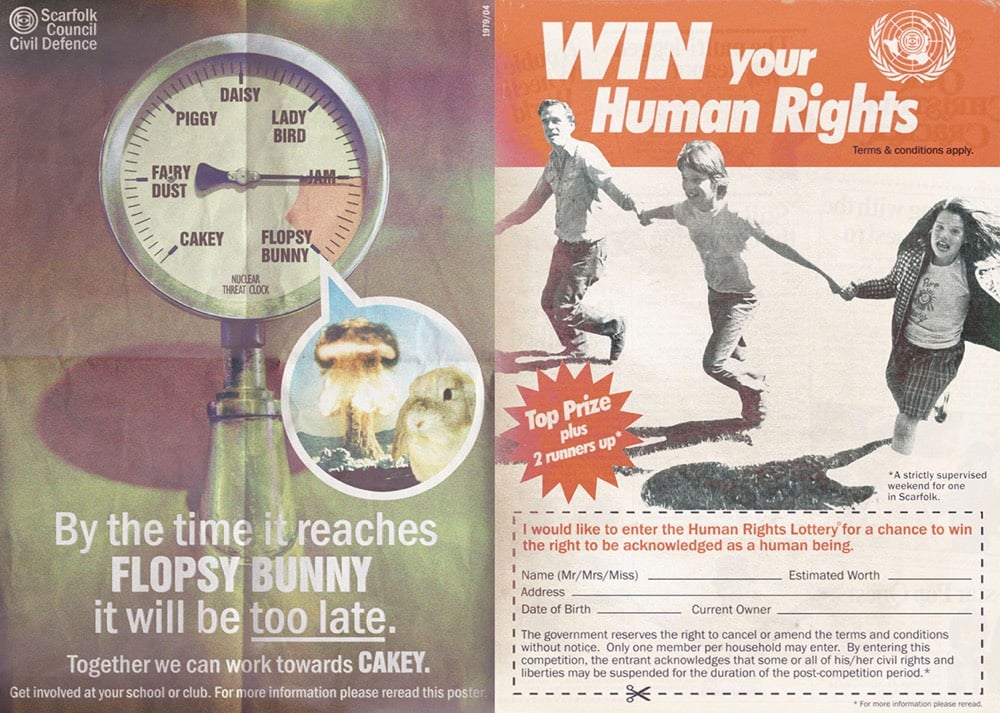
Scarfolk is a dystopian satire site about an English town that’s stuck in a 1970s time loop.
Scarfolk is a town in North West England that did not progress beyond 1979. Instead, the entire decade of the 1970s loops ad infinitum. Here in Scarfolk, pagan rituals blend seamlessly with science; hauntology is a compulsory subject at school, and everyone must be in bed by 8pm because they are perpetually running a slight fever. “Visit Scarfolk today. Our number one priority is keeping rabies at bay.” For more information please reread.
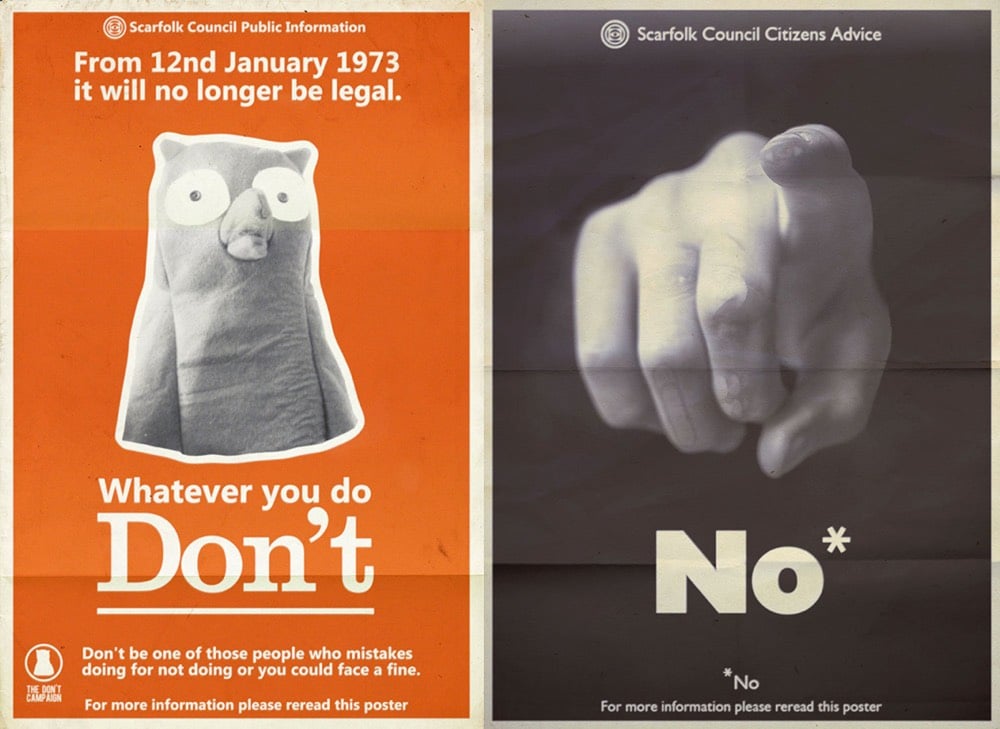

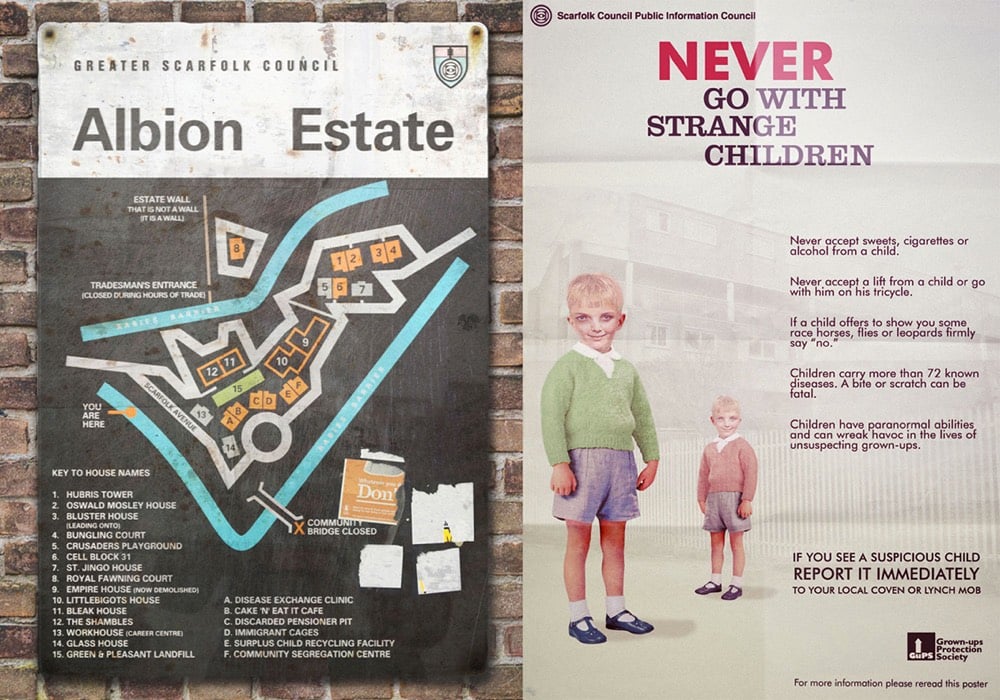
The slogans and advertisements the site produces are fantastic. It’s Nice That has a good overview of the some of the best pieces.
Spotify playlist of rap songs featuring technology. There are songs called “Microsoft Word”, “Lyft (Fuck a Uber)”, and “Twitter Song”.
How to Keep Going
I really enjoyed listening to Austin Kleon’s recent talk about how to press forward when doing creative work, even when times get challenging. He talked about ten strategies for keeping yourself moving forward. In addition to “you’re allowed to change your mind”, I particularly liked “forget the noun, do the verb” (don’t worry about being a writer, focus on writing) and “the ordinary + extra attention = the extraordinary” (because sometimes I feel like 80% of what I do on this here site is pay more attention than everyone else…like, that’s the secret sauce).
Update: Kleon posted a transcript of his talk on Medium. Here’s a list of his 10 ways to keep going:
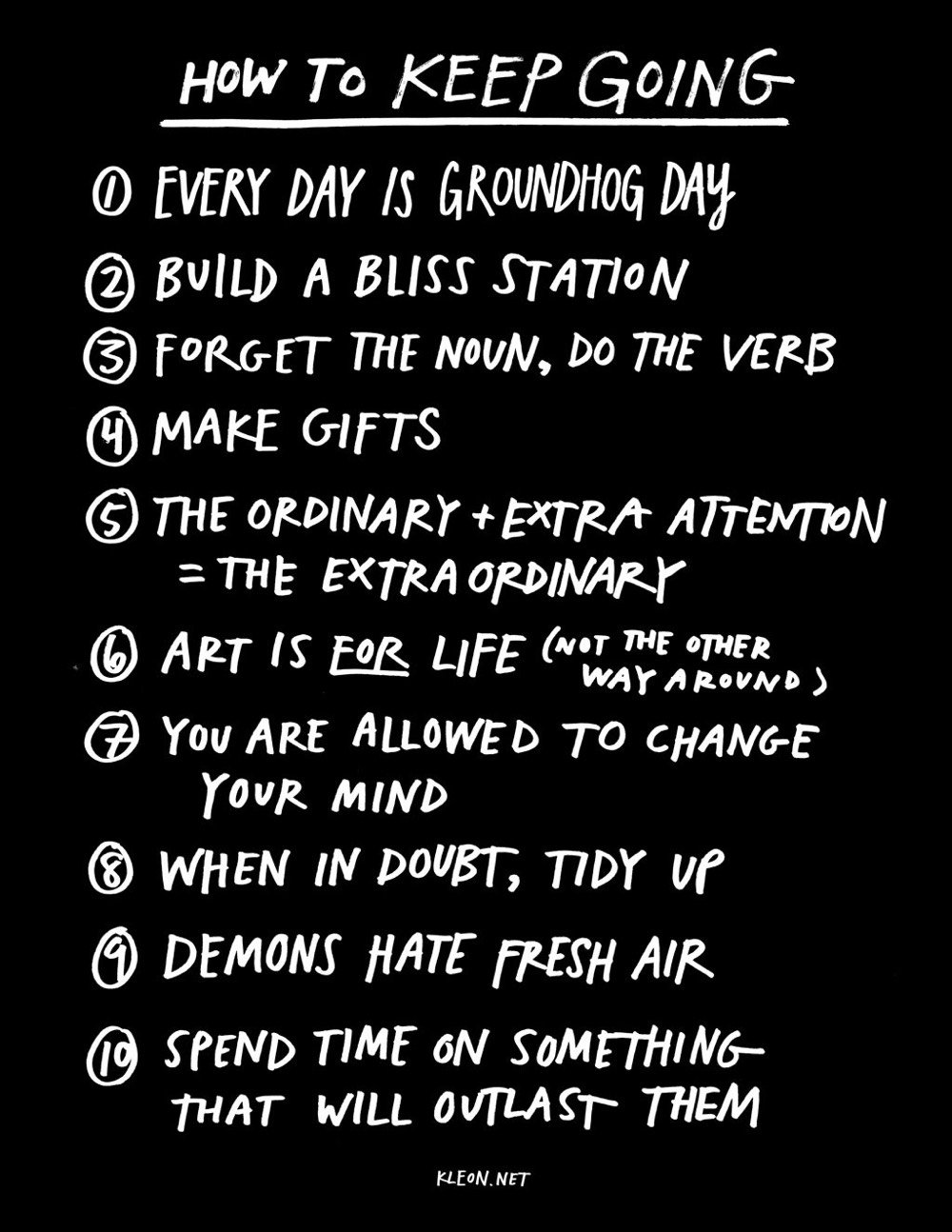
GIFs of ancient ruins restored

From Expedia, a series of animated GIFs that show what ancient ruins from around the world would look like if they were restored. They did The Parthenon (above), Pompei’s Temple of Jupiter, Hadrian’s Wall, the Luxor Temple in Eqypt, and the Nohoch Mul Pyramid in Mexico:

I climbed Nohoch Mul during a recent visit to Coba. (via colossal)
Being Serena
Being Serena is a five-art HBO documentary series on Serena Williams that focuses on her pregnancy, the birth of her daughter, and her determination to get back on the court and compete at a championship level.
I don’t know if there’s anything left for me in tennis, but I’m not done yet.
The first episode will air on May 2. Deadline has further details.
Retired Supreme Court Justice John Paul Stevens: Repeal the Second Amendment
In an opinion piece for the NY Times, former Supreme Court Justice John Paul Stevens advocates for the repeal of the Second Amendment.
That support is a clear sign to lawmakers to enact legislation prohibiting civilian ownership of semiautomatic weapons, increasing the minimum age to buy a gun from 18 to 21 years old, and establishing more comprehensive background checks on all purchasers of firearms. But the demonstrators should seek more effective and more lasting reform. They should demand a repeal of the Second Amendment.
Concern that a national standing army might pose a threat to the security of the separate states led to the adoption of that amendment, which provides that “a well regulated militia, being necessary to the security of a free state, the right of the people to keep and bear arms, shall not be infringed.” Today that concern is a relic of the 18th century.
I completely agree with this. Weaponry deserves no special place in our country’s Bill of Rights and hasn’t for decades.
Older Japanese women are shoplifting to find community and meaning in jail


In Japan, where 27.3% of the population is 65 or older, elderly women are committing petty crimes like shoplifting in order to go to jail to find care and community that is increasingly denied them elsewhere. Japan’s jails are becoming nursing homes.
Why have so many otherwise law-abiding elderly women resorted to petty theft? Caring for Japanese seniors once fell to families and communities, but that’s changing. From 1980 to 2015, the number of seniors living alone increased more than sixfold, to almost 6 million. And a 2017 survey by Tokyo’s government found that more than half of seniors caught shoplifting live alone; 40 percent either don’t have family or rarely speak with relatives. These people often say they have no one to turn to when they need help.
Even women with a place to go describe feeling invisible. “They may have a house. They may have a family. But that doesn’t mean they have a place they feel at home,” says Yumi Muranaka, head warden of Iwakuni Women’s Prison, 30 miles outside Hiroshima. “They feel they are not understood. They feel they are only recognized as someone who gets the house chores done.”
All photos by Shiho Fukada. The first photo is of Mrs. F, aged 89, who stole “rice, strawberries, cold medicine”. She says: “I was living alone on welfare. I used to live with my daughter’s family and used all my savings taking care of an abusive and violent son-in-law.” The woman in the second photo recounts:
The first time I shoplifted was about 13 years ago. I wandered into a bookstore in town and stole a paperback novel. I was caught, taken to a police station, and questioned by the sweetest police officer. He was so kind. He listened to everything I wanted to say. I felt I was being heard for the first time in my life. In the end, he gently tapped on my shoulder and said, ‘I understand you were lonely, but don’t do this again.’
I can’t tell you how much I enjoy working in the prison factory. The other day, when I was complimented on how efficient and meticulous I was, I grasped the joy of working. I regret that I never worked. My life would have been different.
I enjoy my life in prison more. There are always people around, and I don’t feel lonely here. When I got out the second time, I promised that I wouldn’t go back. But when I was out, I couldn’t help feeling nostalgic.
Photographer captures the same people on the same NYC street corner many times over 9 years


For 9 years, photographer Peter Funch stood on a street corner near Grand Central Terminal, photographing the same people over and over again on their commutes to work…often wearing the same clothes and drinking the same drink. The result is 42nd and Vanderbilt (also available as a book).
The corner of 42nd Street and Vanderbilt Avenue… what’s that? It’s a patch of nowhere that hides, like similar patches of nowhere, in all cities everywhere. It’s the space of Edward Hopper. It’s the real estate equivalent of a Styrofoam packing peanut. It’s blank, and it’s in this blankness that we circle back to Warhol and repetition and the aesthetic experience we enjoy when we look from one Marilyn to the next to see which screened face has what kind of silkscreen printing error.
Reminds me a little of several things, but mostly of Hans Eijkelboom’s People of the Twenty-First Century.
The Philharmonic Turntable Orchestra
A turntable orchestra that includes several past DJ world champions recently performed Mendelssohn’s Concerto in E Minor, which was the first LP released back in 1948.
I love everything about this: the history, the music, and the aesthetic of the performers sitting on the floor with their shoes off, wearing tuxedos with optional non-fancy headwear.
Facial recognition AIs have a hard time with dark skin
For her Gender Shades project, MIT researcher Joy Buolamwini fed over 1000 faces of different genders and skin tones into three AI-powered facial recognition systems from Microsoft, IBM, and Face++ to see how well they could recognize different kinds of faces.
The systems all performed well overall, but recognized male faces more readily than female faces and performed better on lighter skinned subjects than darker skinned subjects. For instance, 93.6% of gender misclassification errors by Microsoft’s system were of darker skinned people.

Her message near the end of the video is worth heeding:
We have entered the age of automation overconfident yet underprepared. If we fail to make ethical and inclusive artificial intelligence, we risk losing gains made in civil rights and gender equity under the guise of machine neutrality.
I recommend that you read The Wizard and the Prophet
A couple of weeks ago, I finished Charles Mann’s The Wizard and the Prophet. Normally I shy away from terms like “must-read” or “important” when talking about books, but I’m making an exception for this one. The Wizard and the Prophet is an important book, and I urge you to read it. (The chapter on climate change, including its fascinating history, is alone worth the effort.)
Mann is the author of 1491 and 1493 (both excellent, particularly 1491, which is one of my favorite nonfiction books ever) and I’ve been thinking of this one as the natural third part of a trilogy — it easily could have been called 2092. The Wizard and the Prophet is about two “dueling visions” of how humanity can provide food, energy, housing, and the pursuit of happiness to an estimated population of 10 billion in 2050 and beyond. According to Mann, this struggle is exemplified by two men: William Vogt and Norman Bourlag. The book, in a nutshell:
Vogt, born in 1902, laid out the basic ideas for the modern environmental movement. In particular, he founded what the Hampshire College demographer Betsy Hartmann has called “apocalyptic environmentalism” — the belief that unless humankind drastically reduces consumption its growing numbers and appetite will overwhelm the planet’s ecosystems. In best-selling books and powerful speeches, Vogt argued that affluence is not our greatest achievement but our biggest problem. Our prosperity is temporary, he said, because it is based on taking more from Earth than it can give. If we continue, the unavoidable result will be devastation on a global scale, perhaps including our extinction. Cut back! Cut back! was his mantra. Otherwise everyone will lose!
Borlaug, born twelve years later, has become the emblem of what has been termed “techno-optimism” or “cornucopianism” — the view that science and technology, properly applied, can help us produce our way out of our predicament. Exemplifying this idea, Borlaug was the primary figure in the research that in the 1960s created the “Green Revolution,” the combination of high-yielding crop varieties and agronomic techniques that raised grain harvests around the world, helping to avert tens of millions of deaths from hunger. To Borlaug, affluence was not the problem but the solution. Only by getting richer, smarter, and more knowledgeable can humankind create the science that will resolve our environmental dilemmas. Innovate! Innovate! was Borlaug’s cry. Only in that way can everyone win!
Or put more succinctly:
Prophets look at the world as finite, and people as constrained by their environment. Wizards see possibilities as inexhaustible, and humans as wily managers of the planet. One views growth and development as the lot and blessing of our species; others regard stability and preservation as our future and our goal. Wizards regard Earth as a toolbox, its contents freely available for use; Prophets think of the natural world as embodying an overarching order that should not casually be disturbed.
To combat climate change, should we stop flying (as meteorologist Eric Holthaus has urged) & switch to renewable energy or should we capture carbon from coal plants & build nuclear power plants? GMO crops or community-based organic farming? How can 10 billion people be happy and prosperous without ruining the planet?
I came to this book with an open mind, and came away far more informed about the debate but even more unsure about the way forward. The book offers no easy answers — it’s difficult to tell where Mann himself stands on the wizard/prophet continuum (although I would suspect more wizard than prophet, which is likely my leaning as well) — but it does ask many of the right questions. Wizards can order the book from Amazon while Prophets should seek it out at their local bookstore or library.
Further reading: an interview with Mann in Grist; Can Planet Earth Feed 10 Billion People?, an Atlantic article by Mann; The Edge of the Petri Dish, a piece by Mann in The Breakthrough; State of the Species, a 2012 piece by Mann that was an early attempt at W vs P; and The Wizard and the Prophet: On Steven Pinker and Yuval Noah Harari.
Incredible lava photos from Hawaii’s Volcanoes National Park

For his project Cascade of Lava, photographer Michael Shainblum captured several photos of lava pouring out into the ocean in Volcanoes National Park in Hawaii. The double rainbow one is just…
Shainblum also took some photos during the solar eclipse last year.
Sorry for the delay, the Noticing newsletter just went out! Did you know that if you say “Isle of Dogs” out loud, it sounds like “I love dogs”!?
Wes Enzinna tags along with prolific hitchhiker Juan Villarino on a 1000-mile trip in Africa. “You don’t catch a ride with your thumb. You catch it with a smile.”
‘Isle of Dogs’ Backlash: Wes Anderson Criticized for Racial Stereotypes and ‘Marginalizing Japanese Culture’
The British Museum of Your Stuff. “A team of museum experts obtained this almost new wallet by jostling a tourist on a Nevsky Prospekt trolleybus in St. Petersburg, Russia, and relieving him of it — tough cheese on him.”
The Miscellany of Iskander Sultan

It’s relatively difficult to find decent shortlists of the most beautiful books ever made. Here’s an all-European one made by a medievalist and facsimile expert, with the Lindisfarne Gospels as number one.
I wonder where the Miscellany of Iskander Sultan might fit in if you made the list worldwide. It’s 15th century, Persian, tiny, and gorgeous. It’s certainly one of the most beautiful books, cover to cover, I’ve ever seen. (You can peruse the pages at the British Library’s website).

Its content is also much more my speed:
Imagine being a position to commission a magnificent one-volume selection of the reading matter you would most like to carry around on your travels - a kind of miniature personal library. With no expense spared, you could order the most skilful calligraphers in the land to write it, the best painters to illustrate it, the best illuminators to decorate it, the best binders to bind it…
[The 23 texts in the Miscellany] include a wide-ranging selection of religious, narrative and lyrical poetry; in prose, there are treatises on astronomy and astrology, geometry, medicine, farriery, alchemy, history, and Islamic law.
It’s just 5” by 7”. This was a personal book, fashioned to look like a jewel box.

It’s a Borgesian fantasia.
Although the paintings are marvelous, it is the formatting of the text that makes the book truly striking. The manuscript is collage-like in appearance. The text is arranged like a work of architecture, each chunk of calligraphy interlocking with another like the pieces of a puzzle box. The gathered excerpts that comprise the Miscellany are stitched together on its pages like patches on a quilt. Sections of text stack on top of one another, interlaced like fretwork. Bursts of flowers and tangles of vines fill the empty spaces between sections of writing. In one spread, a poem sits in a block at the center of each page, while another poem radiates out from it like rays of light. In another, a bright painting fills the page, while a golden block of text zigzags around its corner. The pages of this book cannot be read in the usual way. They must be navigated and explored, wandered through like labyrinths.

How exciting is that?
Blogging, social media, and ambient humanity
Dan Cohen is a history professor and administrator at Northeastern University; he was also the executive director of the Digital Public Library of America, and has been a general public smartypants in the field of digital humanities.
Dan recently wrote a blog post titled “Back to the Blog,” which muses on a microtrend I’ve seen as well. Friends and writers, not thousands or probably even hundreds, but solid dozens, returning to old-fashioned weblogging as a way to get their thoughts in order, take ownership of their intellectual property, get away from the Twitter hubbub, stick it to Facebook, or any one of a dozen other reasons to write a blog.
Now, a lot of the professional infrastructure of blogging that once was is broken. The ad networks that supported people don’t exist or don’t work the same way. The distribution, via RSS and then Google Reader, was monopolized and then fractured. Some of the blogging networks take as much of a walled-garden approach to their sites as Facebook does.
But, if you just want to blog (which is different from making a living as a blogger), it’s probably easier to start and host your own blog than it ever was. What’s holding people back, Cohen writes, isn’t really technical:
It is psychological gravity, not technical inertia, however, that is the greater force against the open web. Human beings are social animals and centralized social media like Twitter and Facebook provide a powerful sense of ambient humanity—the feeling that “others are here”—that is often missing when one writes on one’s own site. Facebook has a whole team of Ph.D.s in social psychology finding ways to increase that feeling of ambient humanity and thus increase your usage of their service.
The metaphor suggests that blogging either needs its own mechanisms of ambient humanity — which it’s had, in the form of links, trackbacks, conversations, even (gulp) comments, all of which replicated at least a fraction of the buzz that social media has — or it needs a kind of escape velocity to break that gravitational pull. Gravity or speed. Or a hybrid of both.
How @museummammy became the darling of the art world. “I couldn’t find any websites, so I started one.”
Hair Dryer Chicken
My friend Helen Rosner loves crispy poultry. She evangelizes dry-brined turkey and fried chicken given an extra turn under a heat lamp. Others may have been surprised when she turned her hair dryer loose on a roaster in the hopes of sucking just a little more moisture from the bird’s skin before it got properly cooked. I was not.
Happy snow day, I am using an astonishingly expensive hair dryer to remove all moisture from a chicken to maximize skin crispiness when I roast it. pic.twitter.com/ngtzmoOSHf
— Helen Rosner (@hels) March 21, 2018
Hello, gorgeous pic.twitter.com/pIFyganrBM
— Helen Rosner (@hels) March 21, 2018
Here, pretty much, is the recipe. Plus: Roast the bird on a bed of rough-chopped veg to help airflow. And I prefer cast iron but it doesn’t really matter. https://t.co/pLli3OQy0w
— Helen Rosner (@hels) March 21, 2018
Hell of a lifehack, Hels.
Update: Helen has added a full write-up and recipe for hair dryer chicken (or Roast Chicken à la Dyson) at The New Yorker.
A game of tag that’s been going for 20+ years
A group of high school friends has been playing an elaborate game of tag since reconnecting at a reunion almost 30 years ago. A few years ago, one of the players wrote a piece for The Guardian about the game.
Since we had busy lives and lived hundreds of miles apart, we agreed on three rules. First, we would play it only in February each year; second, you were not allowed immediately to tag back the person who had tagged you; and finally, you had to declare to the group that you were “it”.
Now we are grown men, we don’t run like Usain Bolt, so subterfuge and collusion have become our weapons. Eleven months of the year are spent planning. Collaborating with a friend is where the fun is — we can spend hours discussing approaches.
I was tagged spectacularly a few years back when a friend popped round to show me his new car. As I approached it, Sean sprang out of the boot where he’d been hiding and tagged me. He’d flown 800 miles from Seattle to San Francisco just to stop being “it” — to shrug off the “mantle of shame”, as we call it. My wife was so startled she fell and injured her knee, but she wasn’t angry; she was pleased to see Sean.
Hollywood, who knows a winning idea when they see one,1 has now based a movie on the game. Tag stars Jon Hamm, Ed Helms, Jeremy Renner, and Rashida Jones; here’s the trailer:
And if you think some of the tagging scenarios in the movie are too good to be true (a funeral, really?)…yeah, no:
Some things we did early on we wouldn’t do now — like when Mike sneaked into Brian’s house at night, crept into the bedroom and woke him up to tag him, surprising the life out of him and his girlfriend.
Perhaps one of the most unexpected tags was during Mike’s father’s funeral. During the service, he felt a hand on his shoulder and turned to find Joe mouthing, “You’re it.” Afterwards, he said his father would have approved, because he found our game hilarious.
A decades-long game of adult tag is exactly the type of thing I love reading about but would never participate in. I am a huge stick-in-the-mud, but I’ve made my peace with it.
This clearly isn’t true, but roll with me here.↩
Great behind-the-scenes look at the Spike Jonze / FKA Twigs Apple ad from a couple weeks ago. I *love* the practical effects they used.
“Search the web to plant trees…” The Ecosia search engine donates a significant portion of its profits to plant trees (23 million so far).
Hip Hop All Stars on The Arsenio Hall Show
For the final show of The Arsenio Hall Show, Queen Latifah organized a huge amount of hip hop talent for a tribute. It’s amazing. Some more details here. The segment features Yo-Yo, MC Lyte, Naughty by Nature, A Tribe Called Quest, Fu-Schnickens, CL Smooth, Guru from Gang Starr, Das EFX, GZA and few others from Wu-Tang Clan, KRS-One, and Mad Lion, and, as mentioned previously, is amazing. (via @mattwhitlockPM)
The 100 Most Jewish Foods. Love the spinning table interface.
The influences of Call Me By Your Name
In this episode of the Nerdwriter, Evan Puschak imagines a film school class that studies the influences of Call Me By Your Name, which include a pair of Merchant Ivory films, A Room With a View and Maurice. One of the best love stories I’ve seen in recent years, Call Me By Your Name is one of those movies I’m waiting to watch again after some time, saving it like the last chocolate in the box.
Prompted by a question from my kids: How big is a quark? “the radius of the quark is smaller than 43 billion-billionths of a centimetre”
The making of seven iconic movie posters
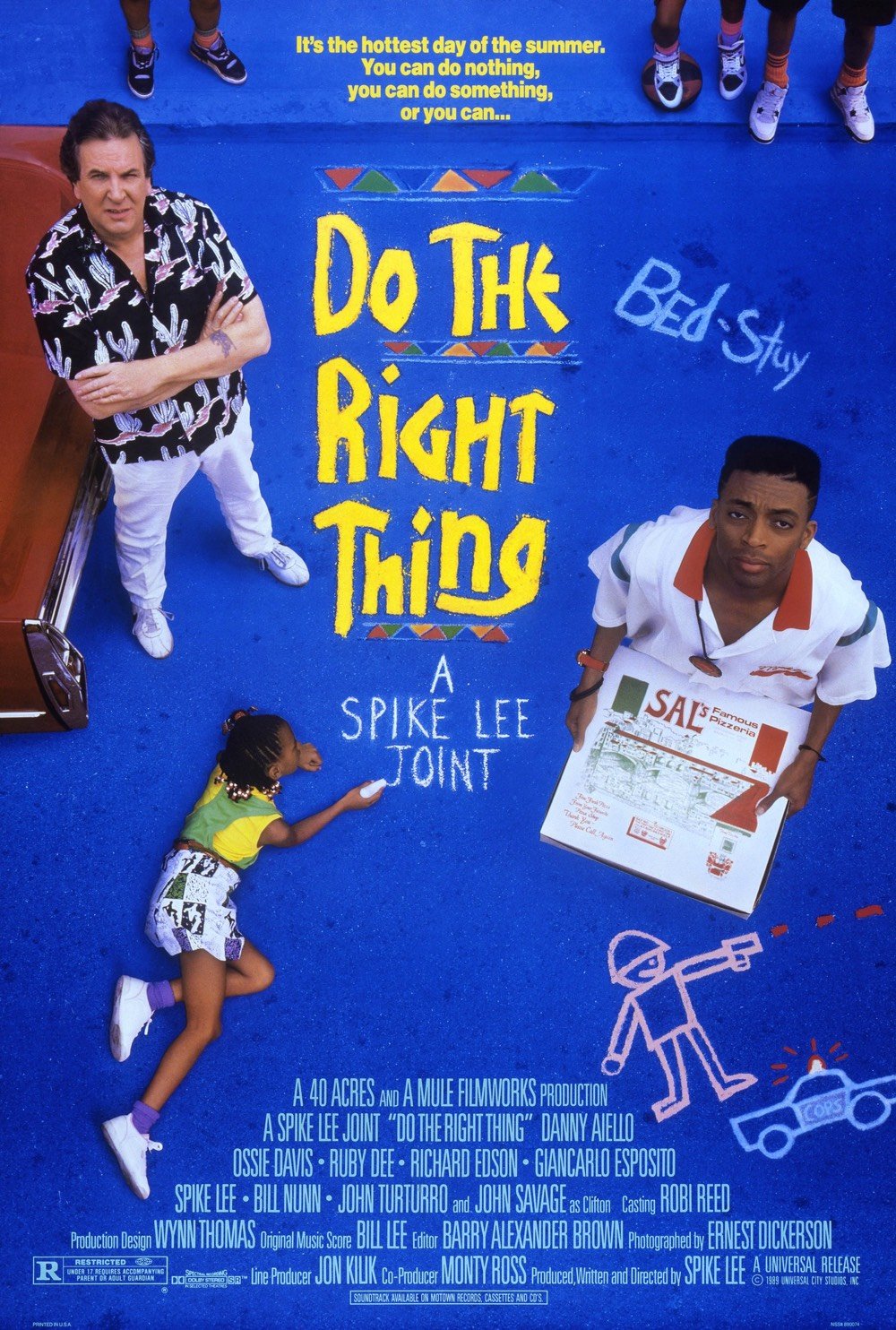
As an art director in the 80s and 90s, Tom Martin created some of that era’s most memorable movie posters. In this post, Tony Pierce writes about the creation of seven of Martin’s most iconic posters, including those for Jurassic Park, Do The Right Thing, Twins, and Schindler’s List.
On a very different Steven Spielberg film, Schindler’s List, some of the submissions that weren’t chosen as the final poster are as interesting as the one that was due to the fame of their designers.
Tony Seiniger, Anthony Goldschmidt, and Bill Gold were among the designers who took a crack at the poster. And then there was legendary designer Saul Bass.
“It was one of the high points of my career,” Martin says. “I was in a meeting at a sound studio and it was Saul Bass, Steven Spielberg, and myself, in a room, looking at Saul’s poster.”
Even though Bass was well established at that point in his career he still fought for his ideas and pitched his posters to Spielberg with as much conviction as anyone.
“There was still that competitive drive,” Martin remembers. “Saul was still competitive. He still wanted to be chosen, still… wanted that approval.”
Unfortunately for Bass, his work ultimately lost out to independent art director Georgia Young who designed the final poster.
See also this massive online collection of movie posters and this other massive online collection of movie posters.
An honest trailer for every Wes Anderson movie
As Isle of Dogs prepares to enter theaters,1 Honest Trailers created a bitingly truthful trailer for all of Wes Anderson’s films, in which they ding the director for symmetry, nostalgia, whimsey, whip pans, the overwhelming maleness of his ennui-suffering & disaffected protagonists, and Bill Murray on a tiny motorcycle in a profile shot. The description of his films as “meticulously crafted awkward family fables that make you kinda happy, kinda sad, and kinda unsure when you’re supposed to laugh or not” is pretty much spot-on and the reason I like them so much.
In 2012, before the release of Moonrise Kingdom, Anderson talked about his approach to movies on NPR’s Fresh Air:
I have a way of filming things and staging them and designing sets. There were times when I thought I should change my approach, but in fact, this is what I like to do. It’s sort of like my handwriting as a movie director. And somewhere along the way, I think I’ve made the decision: I’m going to write in my own handwriting. That’s just sort of my way.
And that’s why he’s “your barista’s favorite director”.
But only in a limited release, as I found out this morning. 27 theaters this weekend and not in wide release until April 13. I’d have to drive to fricking Boston to see it earlier than that. :(↩
Stunt pilot restarts his single engine in the nick of time
I always feel a little silly when I click through to watch videos with titles like “Plane Miraculously Flies To Safety After Sudden Engine Failure”, like I’m indulging in clickbait, a sugary online snack when I’m supposed to be consuming healthier fare. But my dad was a pilot when I was a kid, so I will watch any flying video that comes along (along with 35 minutes of “related videos” on YouTube…send help!)
But this one in particular is worth a look because all the drama lasts for less than a minute and the first person view from the camera (which is mounted on the pilot’s head) puts you right into the cockpit.1 One of the coolest things about wearable cameras like the GoPro is that ability to put the viewer into the action, to create a visceral sense of empathy with that person doing that thing. That pilot’s eyes are our eyes for those 60 seconds. You see the engine fail. Your arm reaches out to the controls and attempts to address the problem. You pull the plane up into a glide. You look around for somewhere to ditch. Ah, there. You turn the plane. You keep trying to restart the engine… I don’t know about you, but my palms were pretty sweaty by the time that video was over.
I’ve been paying way more attention to the different ways in which filmmakers use the camera to create this sort of empathy since watching Evan Puschak’s video on how David Fincher’s camera hijacks your eyes. The first-person camera view, where the camera moves as if it were swiveling around on a real person’s neck, is a particularly effective technique. Even if the scene in this video weren’t real, it would be difficult to convince your brain otherwise given your vantage point. (via digg)
And don’t skimp on the sound either, put those headphones on. The sound of the suddenly rushing wind after the engine quits, of gravity asserting itself, is quite alarming.↩
Max Richter’s Sleep, an 8-hour album designed to be listened to while you sleep
Composer Max Richter released Sleep in 2015, but it only recently became available on streaming platforms: Spotify, Amazon, Apple Music, Tidal. The album is 8 hours and 24 minutes long and was designed by Richter as a sleep aid/accompaniment. The composer worked with neuroscientist David Eagleman to align the music with the brain & body’s natural sleep rhythms.
A snack-sized version of Sleep is also available: From Sleep, which clocks in at a mere hour long.
Fashion Climbing, photographer Bill Cunningham’s secret memoir
This is kind of amazing. Legendary street fashion photographer Bill Cunningham died two years ago, leaving behind a massive body of work documenting the last 40 years of the fashion world. Somewhat surprisingly, he also wrote a memoir that seemingly no one knew about. He called it Fashion Climbing (pre-order on Amazon).
Fashion Climbing is the story of a young man striving to be the person he was born to be: a true original. But although he was one of the city’s most recognized and treasured figures, Bill was also one of its most guarded. Written with his infectious joy and one-of-a-kind voice, this memoir was polished, neatly typewritten, and safely stored away in his lifetime. He held off on sharing it — and himself — until his passing. Between these covers, is an education in style, an effervescent tale of a bohemian world as it once was, and a final gift to the readers of one of New York’s great characters.
The NY Times, where Cunningham worked for decades, has more information on the book.
“There I was, 4 years old, decked out in my sister’s prettiest dress,” reads the memoir’s second sentence. “Women’s clothes were always much more stimulating to my imagination. That summer day, in 1933, as my back was pinned to the dining room wall, my eyes spattering tears all over the pink organdy full-skirted dress, my mother beat the hell out of me, and threatened every bone in my uninhibited body if I wore girls’ clothes again.”
The wonderful documentary about Cunningham is currently available on Amazon Prime. I was lucky enough to catch Cunningham at work on the streets of NYC, once at the Union Square Greenmarket and another time during Summer Streets. Watching him snap away with his camera in that blue coat of his, bicycle propped nearby, was thrilling for me, like watching a superhero dispatching bad guys on the streets of Metropolis or Gotham.1
Almost as thrilling was watching Maira Kalman sketching people at a MoMA cafe. We usually only ever see the output of artists, so watching them actually at work is a special thing.↩
12 Things Everyone Should Understand About Tech
From Anil Dash, 12 Things Everyone Should Understand About Tech.
1. Tech is not neutral. One of the most important things everybody should know about the apps and services they use is that the values of technology creators are deeply ingrained in every button, every link, and every glowing icon that we see. Choices that software developers make about design, technical architecture or business model can have profound impacts on our privacy, security and even civil rights as users. When software encourages us to take photos that are square instead of rectangular, or to put an always-on microphone in our living rooms, or to be reachable by our bosses at any moment, it changes our behaviors, and it changes our lives.
All of the changes in our lives that happen when we use new technologies do so according to the priorities and preferences of those who create those technologies.
Lessening the burden on Wikipedia
In a recent interview at SXSW, YouTube’s CEO Susan Wojcicki said the company planned to use information from Wikipedia to counter misinformation in YouTube’s videos. In the NY Times, John Herrman wrote about the potential burden of a massive company like Google leaning so heavily on a relatively small non-profit organization like Wikipedia.
Then there’s the issue of money. As important as Wikipedia may be to some of the richest companies in the world, it is, in financial terms, comparatively minuscule, with a yearly budget of less than $100 million — a rounding error for big tech. (It should be noted that Google has made one-off contributions to Wikipedia in the past and includes the Wikimedia Foundation in a program through which it matches employee donations, which netted the foundation around $1 million last year.)
A few years ago, I wrote about financially supporting Wikipedia.
I consider it a subscription fee to an indispensable and irreplaceable resource I use dozens of times weekly while producing kottke.org. It’s a business expense, just like paying for server hosting, internet access, etc. — the decision to pay became a no-brainer for me when I thought of it that way.
I also called on other companies to support Wikipedia on a recurring basis:
Do other media companies subscribe to Wikipedia in the same fashion? How about it Gawker, NY Times, Vox, Wired, ESPN, WSJ, New York Magazine, Vice, Washington Post, The Atlantic, Buzzfeed, Huffington Post? Even $500/month is a drop in the bucket compared to your monthly animated GIF hosting bill and I know your writers use Wikipedia as much as I do. Come on, grab that company credit card and subscribe.
Wikipedia is a shared online resource that we all would sorely miss if it went away, people and companies alike. We should all pitch in and support it.
Tomorrow I’ll Be Brave by Jessica Hische
Illustrator Jessica Hische (who did the typeface for Moonrise Kingdom, among many other wonderful things) has written and illustrated a children’s book called Tomorrow I’ll Be Brave.
Lyrically written and beautifully illustrated by award-winning lettering artist Jessica Hische, this book takes readers on a fantastic journey that encourages them to be adventurous, strong, smart, curious, creative, confident, and brave — reassuring them that if they haven’t been able to be all or any of those things today, there is always tomorrow, which is full of endless opportunities.
You can see some spreads from the book on Hische’s site.
The suspected Austin bombing suspect is dead. Authorities say he acted alone but that unexploded bombs may still be out there.
The price of the US invasion of Iraq
Fifteen years ago, the United States invaded Iraq. In the NY Times, Sinan Antoon laments what has become of his country since then: Fifteen Years Ago, America Destroyed My Country. This is a damning final paragraph about George W. Bush and the Republican hawks who used the events of 9/11 to manufacture a war that killed hundreds of thousands of people.
No one knows for certain how many Iraqis have died as a result of the invasion 15 years ago. Some credible estimates put the number at more than one million. You can read that sentence again. The invasion of Iraq is often spoken of in the United States as a “blunder,” or even a “colossal mistake.” It was a crime. Those who perpetrated it are still at large. Some of them have even been rehabilitated thanks to the horrors of Trumpism and a mostly amnesiac citizenry. (A year ago, I watched Mr. Bush on “The Ellen DeGeneres Show,” dancing and talking about his paintings.) The pundits and “experts” who sold us the war still go on doing what they do. I never thought that Iraq could ever be worse than it was during Saddam’s reign, but that is what America’s war achieved and bequeathed to Iraqis.
The trailer for Won’t You Be My Neighbor
Morgan Neville’s documentary about Fred Rogers will be out in theaters on June 8; the trailer above just dropped today.
Fred Rogers led a singular life. He was a puppeteer. A minister. A musician. An educator. A father, a husband, and a neighbor. Fred Rogers spent 50 years on children’s television beseeching us to love and to allow ourselves to be loved. With television as his pulpit, he helped transform the very concept of childhood. He used puppets and play to explore the most complicated issues of the day — race, disability, equality and tragedy. He spoke directly to children and they responded by forging a lifelong bond with him-by the millions. And yet today his impact is unclear. WON’T YOU BE MY NEIGHBOR? explores the question of whether or not we have lived up to Fred’s ideal. Are we all good neighbors?
You can watch a clip of the film here.
A young video blogger with cancer shares her story
When she was 16, Charlotte Eades was diagnosed with glioblastoma, an extremely aggressive form of brain cancer. About a year after the diagnosis, she began documenting her illness and her life on her YouTube channel. After Eades died, her family made the video above, a short tribute to her life and video blog.
20 years of gratitude and acknowledgements
I was on the road for an unexpectedly long time last week, so the post I wrote about kottke.org’s 20th anniversary was a little rushed and incomplete. I often call kottke.org my “one-man band” but it has been anything but. Today, I want to swing back around and thank all of the people and organizations who have supported me and the site with their encouragement, advice, criticism, well-wishes, hard work, and services.
I’ve thanked ‘em before and I’ll thank ‘em again: the support of kottke.org members has given this here webmaster new life. If you’d like to see kottke.org run another 20 years, the best way to do that is to sign up for a membership (it’ll only take you a minute).
I’ve been lucky to work with a bunch of talented guest editors over the years, including Sarah Pavis, Greg Allen, Adam Lisagor, Choire Sicha (now the editor of the NY Times Style section — fancy!), Deron Bauman of the dearly missed Clusterflock, Susannah Breslin, Cliff Kuang, Ainsley Drew, Jenni Leder, Joel Turnipseed, Lance Arthur, Andy Baio, and Chrysanthe Tenentes. Chris Piascik has provided the occasional high quality illustration. Aaron Cohen guest edited for a couple of weeks and then, unbidden & for reasons unknown, posted 3-5 posts each week for several months. (Aaron still bugs me bi-monthly about doing a Kottke Konference and someday he might actually persuade me to do it.)
And a special mention goes to Tim Carmody, who has guest edited several times and is now writing the Noticing newsletter and posting on Fridays. He’s like my smarter and more verbose brother, and I love what he contributes to the site.
Back in 2005, when I quit my job to work on kottke.org full-time, I asked my readers to support me in a precursor to the membership program. Hundreds of them did just that, and I’m forever grateful.
To Greg Knauss, Anil Dash, Heather Armstrong, Michael Sippey, Mark Wilkie, David Jacobs, Meg Hourihan, Jake Dobkin, and Jonah Peretti: your advice and counsel over the years has been invaluable to me. Best informal board of advisors ever.
I need to thank Greg Knauss & Mark Wilkie again, along with Finn Smith, for helping me out with the heavy lifting server admin stuff. Mark in particular hosted kottke.org on his own personal server for many years in the early days.
Along with his counsel, I’d like to thank Jonah Peretti for providing me with a space at Eyebeam Labs in 2005 as a senior fellow and again at Buzzfeed as a design advisor and a desk-squatter for almost 10 years.
kottke.org is proudly hosted by Arcustech, which keeps the site running at top speed with no downtime. I dunno, maybe the site’s been down once, for like 2 seconds in the middle of the night, but I was sleeping and didn’t notice.
The fonts for the site are courtesy of Hoefler & Co. I’m proud to have been one of the first sites on the web to use their web fonts.
I’d like to thank my advertising partners throughout the years: Carbon Ads, We Work Remotely (which started out as the job board for 37signals), and especially The Deck.
And last but not least, I’d like to thank all of you for reading all these years, despite the repeated use of cliches like “last but not least”. I ♥ you all!
CHICken: a coffee table book of beautiful chicken photos



The close reader of the Kickstarter project page for The Most Stunning High Quality Chicken Book Photos Ever Made will notice that the chicken photos coffee table book they’re making is called “CHICken” and not just “Chicken”. Chic chickens. Sheek-en. SHEEEEEEEEK-EN!! I am pronouncing it this way from now on for sure, especially in fancy restaurants. THA SHEEK-EN POR DOO SEAL VOO PLATE.1
See also The Illustrated Book of Poultry. (via colossal)
Perhaps you don’t find this as hilarious as I do, but I grew up in a household where Target and J.C. Penney were pronounced in the French manner, TAR-JHAY and JHOCK PENNAY respectively. I don’t know exactly who we were poking fun at with this: the French we knew nothing about, high-end fashion brands we couldn’t afford, or ourselves (a time-honored Midwestern pastime).↩
A Selfish Argument for Making the World a Better Place
This video, a collaboration between Kurzgesagt and economist Max Roser, makes a compelling argument for empowering the maximum amount of people around the world to become happier/wealthier/more free, so that everyone can all work on solutions to problems that affect everyone. The main gist is that while pre-industrial conditions favored zero-sum thinking, the Industrial & Green Revolutions and global telecommunications have created a situation in which non-zero-sum thinking is favored.
I couldn’t help thinking of the Lost Einsteins due to inequality in America.
I encourage you to take a moment to absorb the size of these gaps. Women, African-Americans, Latinos, Southerners, and low- and middle-income children are far less likely to grow up to become patent holders and inventors. Our society appears to be missing out on most potential inventors from these groups. And these groups together make up most of the American population.
The key phrase in the research paper is “lost Einsteins.” It’s a reference to people who could “have had highly impactful innovations” if they had been able to pursue the opportunities they deserved, the authors write. Nobody knows precisely who the lost Einsteins are, of course, but there is little doubt that they exist.
In addition to the ethical and moral arguments for improving the lives of all humans, the non-zero-sumness of today’s world makes a powerful economic argument for doing so as well. How to accomplish this is left as an exercise to the reader…
The cult of Trump and America’s increasingly authoritarian government
I missed Andrew Sullivan’s review of Cass Sunstein’s Impeachment: A Citizen’s Guide and Can It Happen Here?: Authoritarianism in America (also edited by Sunstein) but I think Sullivan’s twin conclusions are spot on: Trump is likely unimpeachable1 and America is steadily headed towards an authoritarian government.
The result is that an unimpeachable president is slowly constructing the kind of authoritarian state that America was actually founded to overthrow.
There is nothing in the Constitution’s formal operation that can prevent this. Impeachment certainly cannot. As long as one major political party endorses it, and a solid plurality of Americans support such an authoritarian slide, it is unstoppable. The founders knew that without a virtuous citizenry, the Constitution was a mere piece of paper and, in Madison’s words, “no theoretical checks — no form of government can render us secure.” Franklin was blunter in forecasting the moment we are now in: He believed that the American experiment in self-government “can only end in despotism, as other forms have done before it, when the people become so corrupted as to need despotic government, being incapable of any other.” You can impeach a president, but you can’t, alas, impeach the people. They voted for the kind of monarchy the American republic was designed, above all else, to resist; and they have gotten one.
That is an astonishing passage, not only because of the allegation that 225+ years of American democracy is now effectively over because the Constitution does not include the necessary checks to prevent it, but also because it rings true.
As I’ve said before, I don’t think Trump will resign or be impeached…or willingly leave the White House under any circumstance.↩
Errol Morris on Stephen Hawking, “a king of infinite space”
From an interview with Errol Morris on his friend Stephen Hawking (about whom he made a documentary), Morris shares why Hawking’s A Brief History of Time resonated with so many people beyond the scientific community.
I read the book on the plane on the way over. I was surprised, because I had been told that it was a book about theoretical physics and cosmology. But it was something much more than that. It was a work of literature.
He had done something strange and unusual and powerful. He had described himself and his own situation in terms of his science. Hawking’s greatest discovery — Hawking Radiation — was, in its own way, a tour de force. He was combining elements from general relativity, from quantum mechanics, and from thermodynamics in a new way. There’s something extraordinary about it, but what was most extraordinary about it is that here you have this entity, a black hole, from which nothing can escape. The gravitational field is so strong, surrounded by an event horizon. Nothing can escape from the black hole. Nothing inside that event horizon can get out.
What did Hawking show? Hawking showed that black holes are not entirely black. Radiation can escape from a black hole. He showed the mechanism through which this could occur.
At the same time, he’s telling you that he’s been condemned to this chair, to motor neuron disease, to ALS, and is really unable to talk. He’s lost his ability to speak, and now has to use a computer device, a clicker, a screen with a built-in dictionary and cursor. Despite the disease, he’s not trapped inside of himself. He’s able to communicate. He would always cite the famous line from Hamlet, “Bounded …”
“… in a nutshell, and count myself a king of infinite space.”
The whole thing is well worth a read. Like this bit about Hawking’s voice double:
Q: What was the process of working on the film with him like? Not all of those passages are from the book. Were you sending him questions?
A: Yes. He was writing answers, and some of the material was taken from lectures that he had given. Some of it was written for the film. I called him the first nontalking talking head. It became pretty clear that you had to assemble a dictionary of Hawking shots, but there’s no point in interviewing him for those, because it’s not synced. It’s a voice synthesizer. He gave us the voice synthesizer so we could just assemble his voice in the office in Cambridge, Massachusetts, which he insisted on calling “the pseudo-Cambridge.” There’s nothing like this project.
Q: Wait. He sent you the synthesizer so he could send you an answer and then you could feed it through the synthesizer to get the sound of his voice delivering the answer?
A: That’s correct.
New issue of Noticing, fresh off the presses. Featuring thoughts on time, attention, trees, and 20 years of blogging.
John Oliver on Bitcoin, blockchain, and cryptocurrency
Using Beanie Babies, Chicken McNuggets, and the comedy talents of Keegan-Michael Key, John Oliver tries to explain the wild world of Bitcoin, blockchain, and cryptocurrency, the latter of which he describes as “everything you don’t understand about money combined with everything you don’t understand about computers”.
My favorite part was the explanation of how difficult hacking the blockchain is: “[like] turning a Chicken McNugget back into a chicken”.
This was very hard to keep watching after Oliver started detailing cryptocurrency scams and charlatans trying to take advantage of people. One of Oliver’s targets, Brock Pierce, was actually canned from the company he co-founded after the segment aired.
Isle of Dogs cast interviews
As a promo for Wes Anderson’s Isle of Dogs, snippets from the cast interviews were animated using the dog characters played by Tilda Swinton, Bill Murray, Scarlett Johansson, Bob Balaban, and others. It’s amazing how much some of the dogs’ features & expressions mirror those of the actors who provide the voices. The bit starting at 2:30 with Jeff Goldblum is just straight flames.
Sports franchises have changed how players eat. Inside the Philadelphia 76ers’ executive chef’s operation:
Recipes by algorithm
Cover:Cheese is a website charting the progress of EMMA, the Evolutionary Meal Management Algorithm. This is what it sounds-like: a relatively basic attempt to automatically generate food recipes from other recipes.
The trick is, since it’s not just wordplay, and the results can’t be processed and validated by machines alone, somebody’s gotta actually make these recipes and see if they’re any good. And a lot of them are… not very good.
Ingredients
med okra
lot sugar
Instructions:
boil: sugar
okra sugarNOTE: This one is still around. Don’t make it. You basically end up with a pan full of mucus
But there are some surprises. Apparently eggplant mixed with angel’s food cake is pretty tasty. Or at least, tastier than you might guess. Anyways, at least the algorithm is learning, right?
Translating Homer in public

I can’t claim to have finished Emily Wilson’s translation of The Odyssey by Homer — epic poems are, well, epic — but I’m a huge fan of everything I’ve read, and especially Wilson’s Twitter feed, which is often devoted to explicating some small bit of Homeric text and comparing her approach to that of other translators.
Here, for example, she takes on the depiction of the Sirens. I’m going to pick and choose a few tweets, but you should read as much of the thread as you can.
Everyone knows the story of the Sirens from the Odyssey. They’re the singers who tempt all those who sail past to listen to them forever, forgetful of their families. Odysseus, instructed by Circe, has himself bound to the mast so he can listen to their song.
— Emily Wilson (@EmilyRCWilson) March 4, 2018
But the Homeric Sirens passage, in Book 12, is surprising in at least two ways. One is how short it is; the episode has become a much bigger part of the Odyssey in modern retellings than it is in the Homeric poem.
— Emily Wilson (@EmilyRCWilson) March 4, 2018
Secondly, the Sirens in Homer aren’t sexy. e.g. we learn nothing even about their hair — in contrast to other divine temptresses. The seduction they offer is cognitive: they claim to know everything about the war in Troy, and everything on earth. They tell the names of pain.
— Emily Wilson (@EmilyRCWilson) March 4, 2018
This last observation prompted a haunting distillation by Lev Mirov of Odysseus’s journey and his encounter with the Sirens:
This whole thread is amazing but, I think of this:
— Lev Mirov (@thelionmachine) March 5, 2018
the forbidden knowledge Odysseus cannot pass up?
Essentially:
tell me the name
of the hole in my heart
tell me what
this war meant
and what is wrong with me.
(nothing, nothing, nothing, the name of pain is sung.) https://t.co/LlFFxOqVaX
Back to Wilson, who translates the brutally short passage of the sirens this way:
Wilson:
— Emily Wilson (@EmilyRCWilson) March 4, 2018
“Now stop your ship and listen to our voices.
All those who pass this way hear honeyed song
poured from our mouths. The music brings them joy,
and they go on their way with greater knowledge”.
I don’t change my regular iambic pentameter.
She explains:
I wanted the Sirens to sound seductive, but in aural and cognitive ways. I tried to echo some of the alliterating sibilants in the original — a bit like Kaa in Jungle Book, “Trust in Me”. NB: it’s the mouth, not the lips, that matters in most of Odysseus’ troubles at sea.
— Emily Wilson (@EmilyRCWilson) March 4, 2018
Mouths (of giants, whirlpools, cyclopses and men) keep eating the wrong things, and mouths (of goddesses, men, witches, singers and shades) speak and sing to enable or thwart the onward journey. Not lips, which can be pretty and kissable. Mouths are powerful and dangerous.
— Emily Wilson (@EmilyRCWilson) March 4, 2018
Translation is hard, but translation in public is harder and better. There’s a richness in the commentary, and also a reckoning with the accretion of meanings that have come down through past readings, that you don’t often get without diving into scholarly apparatus. It’s not just peeling back the plaster; it’s trying to understand the work that plaster did in holding the whole structure together. Just remarkable.
Update: Dan Chiasson wrote about Wilson’s use of Twitter for the New Yorker.
A world-historical theory of tool use

I love reading and rereading about the origin of humanity. I love that it’s not settled science: we’re still making new discoveries about when humans first left Africa, how and when we interbred with other hominins, and what makes us human in the first place. It’s just the coolest story, which is also every story.
Popular Science has a really nice new primer on the current state of research on early humanity. Embedded in it is a series of studies on tool use by early humans in Kenya that caught my attention. Basically, the tools got smaller and more portable, the materials used were more exotic (sourced from farther away), and they were decorated with pigments.
“That’s where there’s a similarity to technology in recent times; things start out big and clunky and they get small and portable,” says Richard Potts, head of the Smithsonian’s Human Origins Program and a co-author of the papers. “The history [of] technology has been the same ever since.”
I wonder, though, if all three vectors hold up across history: greater portability, greater range of materials, and greater decorative value.
I suspect the null hypothesis would be that technologies that work tend to stay roughly the same over time. (For most of early human history, our tools didn’t change up that much, which is exactly why the burst of activity in east Africa is noteworthy.) You need something to shake things up: either sudden availability of new materials, or a deprivation of old ones (like the Bronze Age collapse, which eventually helped usher in the Iron Age).
As it turns out, that’s exactly what happened.
“One of the things we see is that around 500,000 years ago in the rift valley of southern Kenya, all hell breaks loose. There’s faulting that occurs, and earthquake activity was moving the landscape up and down. The climate record shows there is a stronger degree of oscillation between wet and dry. That would have disrupted the predictability of food and water, for those early people,” Potts says. “It’s exactly under those conditions that almost any organism—but especially a hunter-gatherer human, even an early one—would begin to expand geography of obtaining food or obtaining resources. It’s under those conditions that you begin to run into other groups of hominins and you become aware of resources beyond your usual boundaries.”
It’s been 10 years since The Wire was on TV. Here, some of the stars and creators look back at the show.
A literal world map
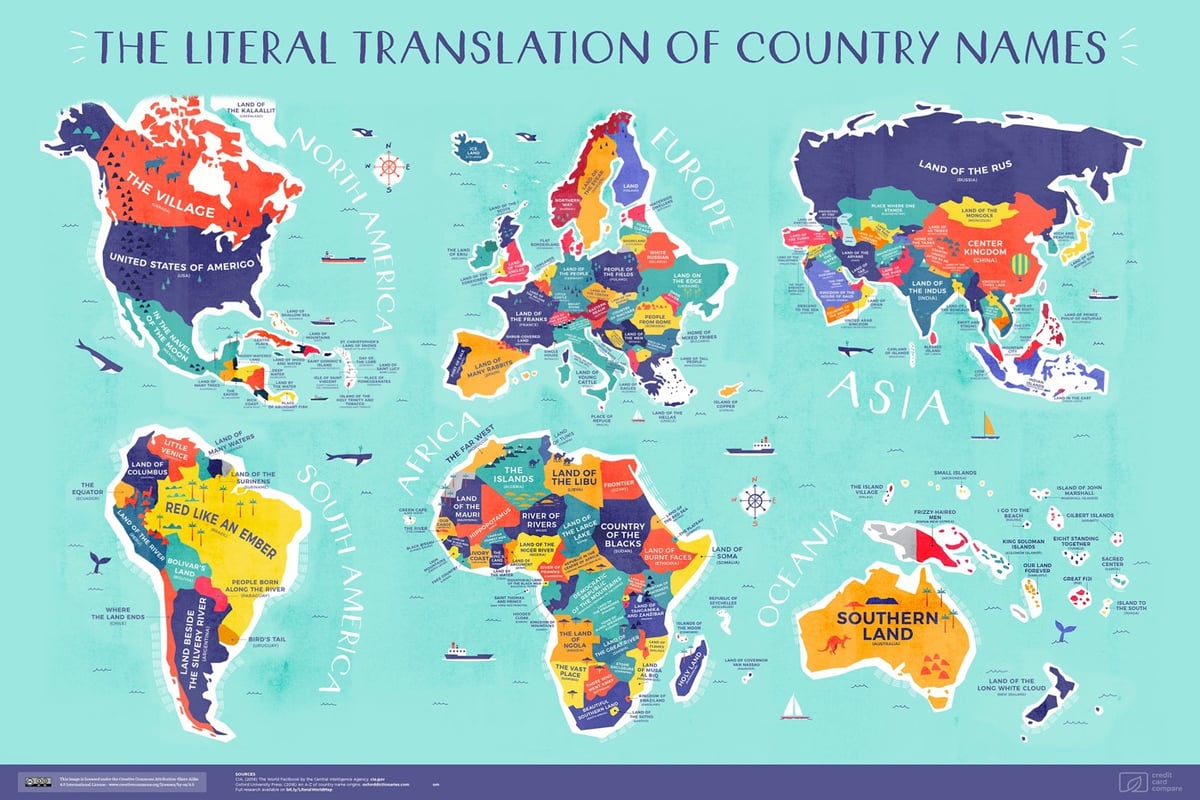
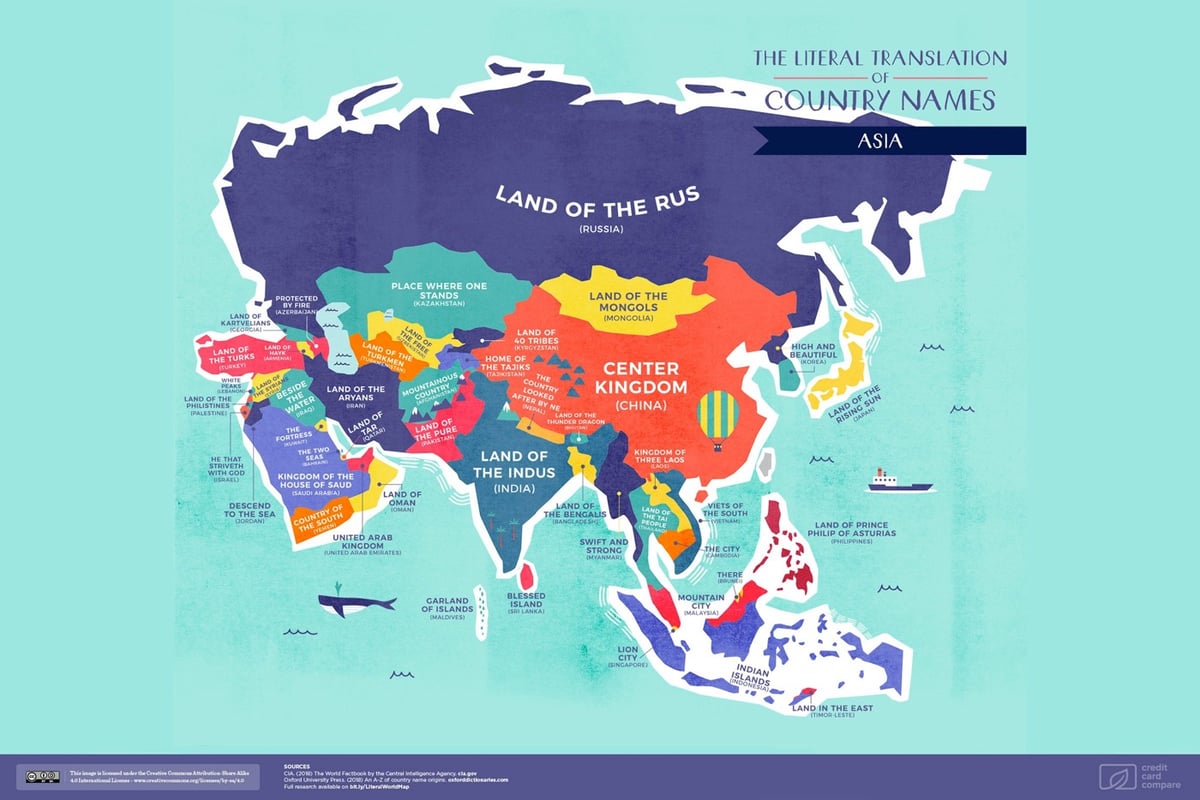
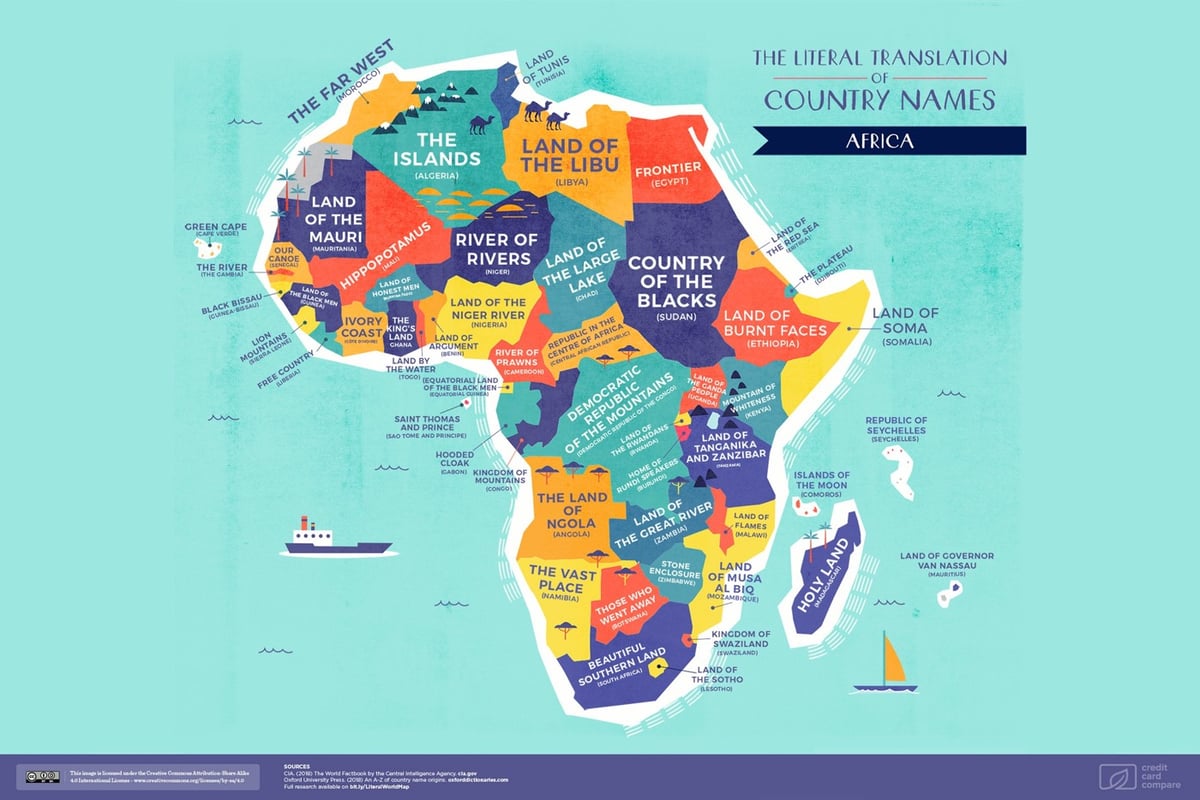
This is a map of the literal translations for the names of the world’s countries (bigger size). Some of the translations include:
Panama: Place of Abundant Fish
Paraguay: People Born Along the River
Namibia: The Vast Place
Ethiopia: Land of Burnt Faces
Egypt: Temple of the Soul of Ptah
Spain: Land of Many Rabbits
Hungary: 10 Arrows
Qatar: Land of Tar
Israel: He That Striveth with God
Thailand: Land of the Free
Nauru: I Go to the Beach
Australia: Southern Land
A spreadsheet of the translations and their sources is available here. See also a world map of every country’s tourism slogan. (via @danielhale)
Update: See also the Etymological Map of Africa. (via @danielhale)
Update: Two things. 1. This is not my map. I didn’t make it…it seems that (based on the logo in the lower right-hand corner) an Australian credit card comparison company did, but I can’t find any record of them having posted it anywhere online. 2. I have gotten many messages indicating the map is incorrect in one aspect or another, so you might want to take the whole thing with a healthy grain of salt (despite the research).
A surgery resident analyzes medical scenes from TV & movies
Annie Onishi is a general surgery resident at Columbia University and Wired asked her to break down scenes from movies and TV shows featuring emergency rooms, operating rooms, and other medical incidents. Spoiler alert: if you seek medical treatment from a TV doctor, you will probably die. Secondary spoiler alert: that adrenaline-shot-to-the-heart scene in Pulp Fiction is not as implausible as you might think, even if some of the details are wrong.
Astronomers have detected radio signals from when the earliest stars in the universe were forming 180 million years after the Big Bang. “If confirmed, this discovery deserves two Nobel Prizes.”
“To Share Something Is to Risk Losing It”
Remember the Broccoli Tree and its eventual fate?
For the past few years, Patrik Svedberg has been taking photos of a beautiful Swedish tree he dubbed The Broccoli Tree. In a short time, the tree gained a healthy following on Instagram, becoming both a tourist attraction and an online celebrity of sorts. (I posted about tree two years ago.) Yesterday, Svedberg posted a sad update: someone had vandalized the tree by sawing through one of the limbs.
Very soon after, it was decided by some authority that the vandalism meant the entire tree had to come down. A work crew arrived and now it’s gone.
In a short video, John Green shares his perspective on the loss of the tree and the meaning of sharing with others in the age of social media.
To share something is to risk losing it, especially in a world where sharing occurs at tremendous scale and where everyone seems to want to be noticed, even if only for cutting down a beloved tree. […] And the truth is, if we horde and hide what we love, we can still lose it. Only then, we’re alone in the loss.
“Oh My God!” People’s Reactions to Looking at the Moon Through a Telescope.
Wylie Overstreet and Alex Gorosh took a telescope around the streets of LA and invited people to look at the Moon through it. Watching people’s reactions to seeing such a closeup view of the Moon with their own eyes, perhaps for the first time, is really amazing.
Whoa, that looks like that’s right down the street, man!
I often wonder what the effect is of most Americans not being able to see the night sky on a regular basis. As Sriram Murali says:
The night skies remind us of our place in the Universe. Imagine if we lived under skies full of stars. That reminder we are a tiny part of this cosmos, the awe and a special connection with this remarkable world would make us much better beings — more thoughtful, inquisitive, empathetic, kind and caring. Imagine kids growing up passionate about astronomy looking for answers and how advanced humankind would be, how connected and caring we’d feel with one another, how noble and adventurous we’d be.
“She found a dating app on her boyfriend’s phone. Then she bought a samurai sword.” There are so many amazing quotes/details here.
A recap and photos of National School Walkout Day

I didn’t get to follow National School Walkout Day as closely as I wanted to yesterday, but I just wanted to say on the morning after that I am very much in support of these kids, very proud of them, and deeply ashamed that ours is a country that has to regularly lean so hard on some of our most vulnerable members of society to get people and politicians to react to gross social injustice.
Buzzfeed has a great roundup of action from around the country, including 16-year-old Justin Blackman, who was the only one to walk out at his school…and ended up with millions of people supporting his efforts online. The Atlantic’s In Focus has gathered 35 photos of the walkout from around the nation.
Ohio teenager’s raw photographs of his high school friends
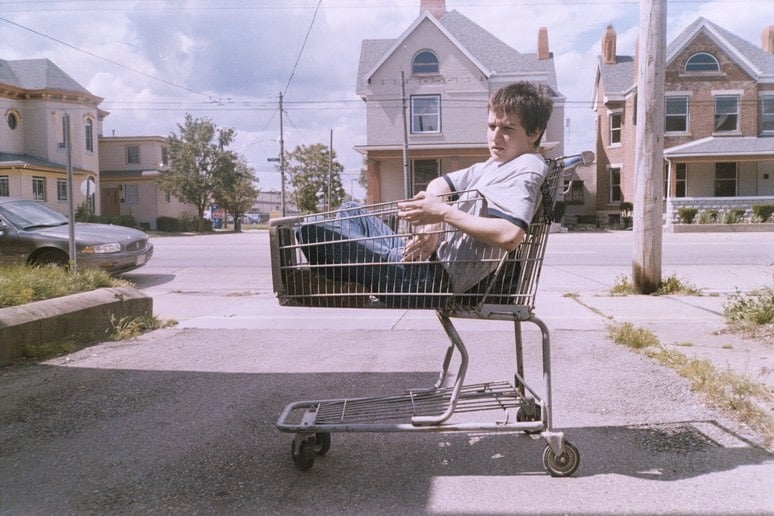

The New Yorker is featuring a selection of photos taken by high school senior Colin Combs, mostly of him and his friends in Dayton, Ohio, “sometimes called the heroin capital of the United States”.
Minimalism is the necessary ethos of both his concept and his process. His equipment consists of expired film and cheap or disposable cameras, which Combs receives from patrons, including Wolfgang Grossmann, a school security guard, and Amy Powell, his photography teacher. Powell, who sent The New Yorker a selection of Combs’s images last December — the magazine later had dozens of rolls developed — has indulged her student’s autodidacticism, a trait that some educators might mistake for disobedience. “Sometimes he won’t do the assignments for class,” she said recently, laughing. “But he is always so hungry, prolific, constantly shooting. I’ve never had a student produce as much.”
The piece compares Combs’ work with that of Nan Goldin; parallels with the work of Larry Clark (NSFW), Ryan McGinley (NSFW), and Harmony Korine are also present. I went to see the Stephen Shore show at MoMA the other day (very recommended) and Combs’ photos making their way to the New Yorker reminded me of a 14-year-old Shore asking Edward Steichen, then MoMA’s curator of photography, to review his portfolio. Steichen purchased three photos from him.
You can follow Combs’ work on Instagram or read more about his work in the local Dayton paper.
Gorgeous 8K video of the aurora borealis dancing in the skies during a lunar eclipse
8K resolution. Time lapse. 360º view. Aurora borealis. Lunar eclipse. I’m not really sure how you could pack much more into this video. Probably best experienced with some sort of VR rig, but for those of us without access to such a thing, watching it several times on a large screen while dragging the view around is a more than adequate substitute. If seeing the aurora borealis in person wasn’t already on your bucket list, it is now. Dang. (via the kid should see this)
Twenty.
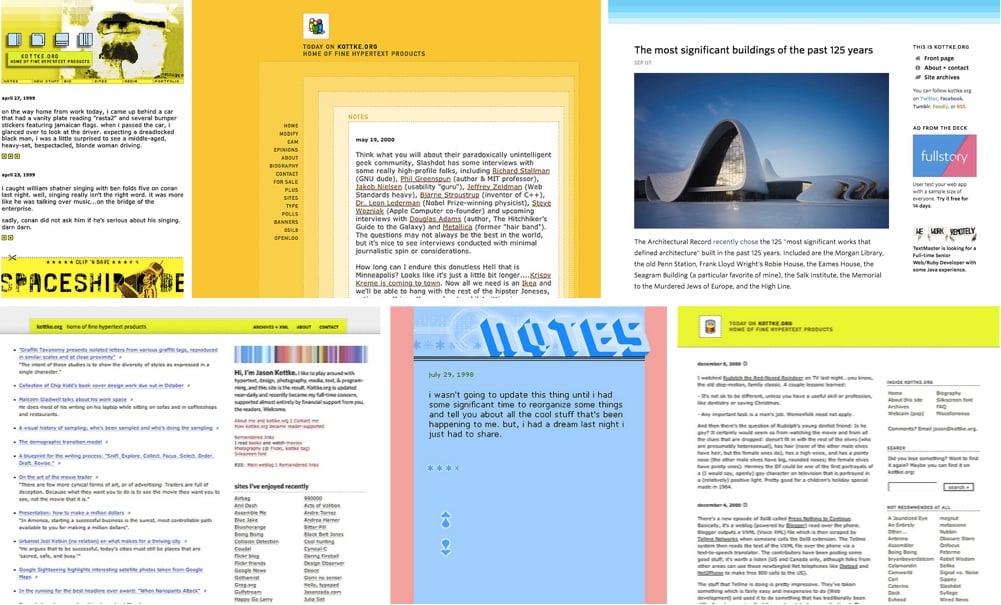
kottke.org is 20 years old today. Holy shit! On March 14, 1998, I launched a new episode of 0sil8 called “Notes”. 0sil8 was a previous website of mine, started in 1995 or 1996. The site’s format was episodic: every month or two the design and content was completely different. With Notes, I wanted to have somewhere to write regularly for my friends, modeled after the online diaries that were growing in popularity at the time. Weblogs were a thing, one of the many types of regularly updated personal sites that were in existence then; they wouldn’t take off and begin to consume all media for another year or two. In December 1998, I registered kottke.org (kottke.com was taken and I wasn’t a network so .org it was) and sometime later moved Notes over, where it’s been ever since. And now it’s one of the oldest regularly updated sites on the web.
I’ve been reading back through the early archives (which I wouldn’t recommend), and it feels like excavating down through layers of sediment, tracing the growth & evolution of the web, a media format, and most of all, a person. On March 14, 1998, I was 24 years old and dumb as a brick. Oh sure, I’d had lots of book learning and was quick with ideas, but I knew shockingly little about actual real life.1 I was a cynical and cocky know-it-all. Some of my older posts are genuinely cringeworthy to read now: poorly written, cluelessly privileged, and even mean spirited. I’m ashamed to have written some of them.
But had I not written all those posts, good and bad, I wouldn’t be who I am today, which, hopefully, is a somewhat wiser person vectoring towards a better version of himself. What the site has become in its best moments — a slightly highfalutin description from the about page: “[kottke.org] covers the essential people, inventions, performances, and ideas that increase the collective adjacent possible of humanity” — has given me a chance to “try on” hundreds of thousands of ideas, put myself into the shoes of all kinds of different thinkers & creators, meet some wonderful people (some of whom I’m lucky enough to call my friends), and engage with some of the best readers on the web (that’s you!), who regularly challenge me on and improve my understanding of countless topics and viewpoints.
I had a personal realization recently: kottke.org isn’t so much a thing I’m making but a process I’m going through. A journey. A journey towards knowledge, discovery, empathy, connection, and a better way of seeing the world. Along the way, I’ve found myself and all of you. I feel so so so lucky to have had this opportunity. When kottke.org turned 10, my post marking the anniversary ended with “I’ll see you in 2018”. In my recollection, that line was somewhat serious but also partially somewhere between a joke and a dare. Like, “how has this thing lasted 10 years, why not go for 20?” So…why not go for 30? 40? I’ll see you for sure in 2028 and perhaps even in 2038. Thank you so very much for being here with me, I surely don’t deserve such fine company.
P.S. And if you’ll indulge me for a moment in a brief shameless sale pitch, if you have found something valuable here over the past 20 years, please consider supporting the site with a membership. Member support has put the site on a stable financial path into the future and has personally re-energized my involvement and commitment to the site. Thanks!
This is still arguably the case.↩
Physics giant Stephen Hawking dead at age 76

Stephen Hawking, who uncovered the mysteries of black holes and with A Brief History of Time did more than anyone to popularize science since the late Carl Sagan, has died at his home in Cambridge at age 76. From an obituary in The Guardian:
Hawking once estimated he worked only 1,000 hours during his three undergraduate years at Oxford. In his finals, he came borderline between a first- and second-class degree. Convinced that he was seen as a difficult student, he told his viva examiners that if they gave him a first he would move to Cambridge to pursue his PhD. Award a second and he threatened to stay. They opted for a first.
Those who live in the shadow of death are often those who live most. For Hawking, the early diagnosis of his terminal disease, and witnessing the death from leukaemia of a boy he knew in hospital, ignited a fresh sense of purpose. “Although there was a cloud hanging over my future, I found, to my surprise, that I was enjoying life in the present more than before. I began to make progress with my research,” he once said. Embarking on his career in earnest, he declared: “My goal is simple. It is a complete understanding of the universe, why it is as it is and why it exists at all.”
From Dennis Overbye’s obit in the NY Times:
He went on to become his generation’s leader in exploring gravity and the properties of black holes, the bottomless gravitational pits so deep and dense that not even light can escape them.
That work led to a turning point in modern physics, playing itself out in the closing months of 1973 on the walls of his brain when Dr. Hawking set out to apply quantum theory, the weird laws that govern subatomic reality, to black holes. In a long and daunting calculation, Dr. Hawking discovered to his befuddlement that black holes — those mythological avatars of cosmic doom — were not really black at all. In fact, he found, they would eventually fizzle, leaking radiation and particles, and finally explode and disappear over the eons.
Nobody, including Dr. Hawking, believed it at first — that particles could be coming out of a black hole. “I wasn’t looking for them at all,” he recalled in an interview in 1978. “I merely tripped over them. I was rather annoyed.”
That calculation, in a thesis published in 1974 in the journal Nature under the title “Black Hole Explosions?,” is hailed by scientists as the first great landmark in the struggle to find a single theory of nature — to connect gravity and quantum mechanics, those warring descriptions of the large and the small, to explain a universe that seems stranger than anybody had thought.
The discovery of Hawking radiation, as it is known, turned black holes upside down. It transformed them from destroyers to creators — or at least to recyclers — and wrenched the dream of a final theory in a strange, new direction.
“You can ask what will happen to someone who jumps into a black hole,” Dr. Hawking said in an interview in 1978. “I certainly don’t think he will survive it.
“On the other hand,” he added, “if we send someone off to jump into a black hole, neither he nor his constituent atoms will come back, but his mass energy will come back. Maybe that applies to the whole universe.”
Dennis W. Sciama, a cosmologist and Dr. Hawking’s thesis adviser at Cambridge, called Hawking’s thesis in Nature “the most beautiful paper in the history of physics.”
Roger Penrose, the eminent mathematician and physicist who collaborated with Hawking on discoveries related to black holes and the genesis of the universe, wrote a lengthy scientific obituary for Hawking in The Guardian.
Following his work in this area, Hawking established a number of important results about black holes, such as an argument for its event horizon (its bounding surface) having to have the topology of a sphere. In collaboration with Carter and James Bardeen, in work published in 1973, he established some remarkable analogies between the behaviour of black holes and the basic laws of thermodynamics, where the horizon’s surface area and its surface gravity were shown to be analogous, respectively, to the thermodynamic quantities of entropy and temperature. It would be fair to say that in his highly active period leading up to this work, Hawking’s research in classical general relativity was the best anywhere in the world at that time.
And then there was that time Hawking threw a party for time travellers but didn’t advertise it until after the party was over (to ensure only visitors from the future would show up).
Tonight is perhaps a good night to watch Errol Morris’ superb documentary on Hawking (with a wonderful Philip Glass soundtrack) or build a version of Hawking out of Lego.
The first trailer for Fantastic Beasts: The Crimes of Grindelwald. I am not loving Jude Law as young Dumbledore.
Holy Mountains Haloed by Drone Light


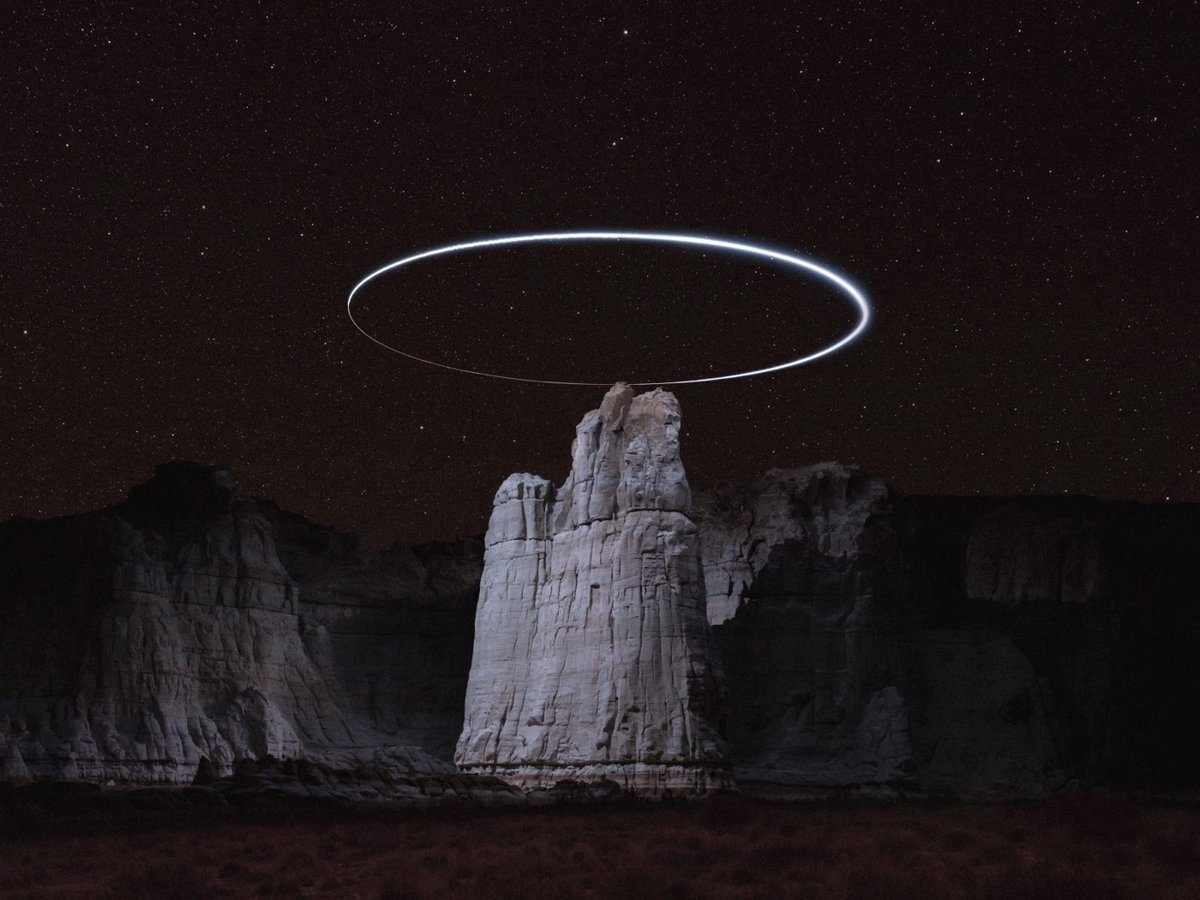
Oh, I love these photos by Reuben Wu. As part of his project Lux Noctis, Wu flies drones in circles around mountain peaks and takes long-exposure photos, creating these beautiful haloed landscapes. Wu spoke to Colossal about his interest in zero-trace land art:
Recently Wu has evolved his process of working with the drones to form light paths above topographical peaks in the mountainous terrain. “I see it as a kind of ‘zero trace’ version of land art where the environment remains untouched by the artist, and at the same time is presented in a sublime way which speaks to 19th century Romantic painting and science and fictional imagery,” said Wu to Colossal.
Broad Band, Claire Evans’ book about “The Untold Story of the Women Who Made the Internet”
I’m looking forward to reading Broad Band: The Untold Story of the Women Who Made the Internet by Claire Evans. Addie Wagenknecht recently did an interview with Evans about the book.
The easy thing is to say that Broad Band is a feminist history of the Internet. That’s what I’ve been telling people. Maybe it’s more accurate to say that it’s a history of the Internet told through women’s stories: boots-on-the-ground accounts of where the women were, how they were feeling and working, at specific, formative moments in Internet history. It emphasizes users and those who design for use, while many popular tech histories tend to zero in on the box. I’ve always been fascinated with what happens after hardware hits the market; it’s what we do with it that counts.
When I first heard of the book, I thought immediately of Halt and Catch Fire, a connection that Adi Robertson picked up on as well.
Robertson: It’s funny how much this book reminded me of Halt and Catch Fire.
Evans: Yes! Oh my god. One of my great regrets about the timing of me writing this book is that Halt and Catch Fire is over now, and I can’t con my way into a consulting job on that show. It was so fun being deep in the process of researching arcana and internet history and then seeing these little nuggets appear in a more glamorous form on my favorite TV show. It kind of felt surreal. But definitely made me feel like I was headed in the right direction.
National Geographic: “For Decades, Our Coverage Was Racist.”
As part of their issue on race, National Geographic asked historian John Edwin Mason to dive into their archives to examine the magazine’s past coverage of people of color, both in the US and abroad. What he found was not pretty.
What Mason found in short was that until the 1970s National Geographic all but ignored people of color who lived in the United States, rarely acknowledging them beyond laborers or domestic workers. Meanwhile it pictured “natives” elsewhere as exotics, famously and frequently unclothed, happy hunters, noble savages — every type of cliché.
Unlike magazines such as Life, Mason said, National Geographic did little to push its readers beyond the stereotypes ingrained in white American culture.
“Americans got ideas about the world from Tarzan movies and crude racist caricatures,” he said. “Segregation was the way it was. National Geographic wasn’t teaching as much as reinforcing messages they already received and doing so in a magazine that had tremendous authority. National Geographic comes into existence at the height of colonialism, and the world was divided into the colonizers and the colonized. That was a color line, and National Geographic was reflecting that view of the world.”
Some of what you find in our archives leaves you speechless, like a 1916 story about Australia. Underneath photos of two Aboriginal people, the caption reads: “South Australian Blackfellows: These savages rank lowest in intelligence of all human beings.”
A laudable move, particularly for a publication owned by Rupert Murdoch.
Puzzle twins



For her project entitled Within 15 Minutes, artist Alma Haser made identical jigsaw puzzles out of portraits she’d taken of identical twins and then swapped every other piece when putting them together, creating these serendipitously fragmented portraits. She said of her first attempt last year:
So today for no apparent reason I thought I’d test out a crazy idea I had. For the project I have been switching just the faces of the identical twins, but today I decided to see what it would look like to swap every other pieces with reach other. Completely entwining the beautiful @being__her sisters. And wow, what an effect! It really make you double take at their faces, trying to decipher one for the other.
You can follow Haser’s work, including the twin puzzles, on Instagram.
I and You: a short appreciation of Martin Buber’s ‘Ich und Du’
When I was in college, I was crazy about Martin Buber. Well, really, I was crazy about Friedrich Nietzsche, and I was dating an evangelical Christian, provisionally going to her church, so I needed a way to put the two together. Buber’s book Ich und Du (I and Thou) was it.
It’s tricky to translate, in one of those “here are some basic differences between English and German” ways. German has two pronouns for you; “du” is the informal one, “sie” the plural or formal. “Sie” is also a third-person pronoun. But “du” is the way you address God, so it winds up turning into “thou.” Still, there’s nothing all that archaic about “du”; you’d call your pets “du.” Kind of like how Freud’s “ich” and “es” become “ego” and “id,” but are really just “I” and “it.” It’s a weird bit of business.
Anyways, Aeon has a new essay on Buber’s I and Thou by a grad student, MM Owen, that’s making me think of picking up Buber again. Here’s his breakdown of the basic insight.
Human existence is fundamentally interpersonal. Human beings are not isolated, free-floating objects, but subjects existing in perpetual, multiple, shifting relationships with other people, the world, and ultimately God. Life is defined by these myriad interactions - by the push and pull of intersubjectivity. This conception ties to Buber’s belief in the primacy of the spoken word. One of his life’s great projects was the 37-year process of producing an idiosyncratic German translation of the Bible wherein, to do justice to its oral roots, the text was divided into ‘breath measures’. For Buber, the act of speech embodied the deep-set interrelatedness of human beings. In speech, as in life, no ‘I’ is an island.
I and Thou argues that within this elementally networked reality there are two basic modes of existence: the I-It, and the I-Thou. These two stances make up our basic ‘twofold attitude’. In the I-It mode, an ‘Ego’ approaches another as an object separate from itself. This type of engagement is driven by a sort of instrumentalism; the object is engaged primarily as something to be known or used, and its nature is always mediated through the subject’s own self-regard. From the I-It stance, we don’t engage with things in their entirety. Instead, we engage with a web of distinct and isolated qualities notable for how they are useful to us. Buber regarded this kind of self-centred outlook - typified, in his view, by proto-existentialists such as Kierkegaard and Nietzsche - as a grave error.
By contrast, in the I-Thou relationship, rather than simply experiencing another, we encounter them. A subject encounters a fellow subject’s whole being, and that being is not filtered through our mediated consciousness, with its litter of preconceptions and projections. ‘No purpose intervenes,’ as Buber put it. The I-Thou stance has a purity and an intimacy, and is inherently reciprocal. In relation to others, he argued, we can step into an intersubjective space where two people coexist in (and co-contribute to) what he called the Between. In this Between lurks the vital, nourishing experience of human life, the real sacred stuff of existence. As he put it: ‘All real living is meeting.’
Is e-paper as good as pen-and-pad really here? (At $700, maybe not quite yet)
“I know a mind virus when I see it.” Paul Ford on cryptocurrency and Silicon Valley’s love for making markets
A close reading of Miyazaki’s sound design in The Wind Rises
I recently rewatched a bunch of Hayao Miyazaki’s films, although “watched” is a bit of a misnomer. I was playing them in the background while I was working, or reading, or trying to sleep, so really I was re-listening to them, and not especially closely.
This almost feels like a sin for movies as beautiful as these, but it did help me notice something. Nausicaa: Valley of the Wind looks different from Princess Mononoke or The Wind Rises, sure; however, it sounds way different. The music, the foley effects, the subtler cues, the sheer sound density are completely different from one end of the career to another.
This made me wonder whether somebody had charted this transformation. I didn’t quite find that, but I did find an outstanding series of blog posts specifically on the sound design in The Wind Rises, which stands in nicely. It’s not well copyedited, but it’s attentive and insightful. A few samples:
Jiro enters his airplane, adjusts his aviator gloves and starts the artisanal machine. By now we have noticed the sound effects of the valves and exhaust pipes made of human mouth sounds and with vocalisations. The first engine starts and it’s clear that human voice is used to portray this activity. But once the propeller activates a low rumble sound effects is introduced, and a sound effect of a servo ascending is applied to the airplane rising, triggered by Jiro’s pulling the lever, and it’s in harmony with the music score. One occurrence with the sound that emphasises the oneiric dimension of this scene is the ‘dreamy’ quality of the reverb applied on the last blow of the machine lifting before it goes crossing the skies [00:02:03].
Here’s a clip a little later in the sequence — I’d never recognized that the dream engine sounds were being made by human mouths, but once you hear it, it’s perfect.
Or consider the earthquake, detail by detail:
It is now that we are in the presence of the horror lived in this earthquake and sound plays such a big role with all its brutality. Different to the traditional approach of western film, the main elements heard are a composition of :
- horrified human screams on a higher-pitch range,
- medium-low pitch throat growls and groans like coming from a big beast,
- that moves upwards in pitch as the image from the houses undulates from a farther plane to a closer one.
- an earthy impact stinger
These elements are introduced a couple of frames before we see the houses being ripped apart.
In the next scene the audience is shown, through close-ups, how the ground is animated in brutal waves breaking and disrupting the order of all man-made constructions. We no longer hear the horrifying screams and the sound designer paints the scene with sound of the ground disrupting, by utilising rumbles and earth debris. The sounds here are in the same universe as those indicated on Jiro’s first dream - choir-like sounds mimicking up and down movements, in which the upwards vocalisations are like rising stingers.
It really helped me appreciate these movies again, as sonic masterpieces.
What America looked like before the EPA, in photos
Popular Science has a series of photos taken by EPA staff in the early years of the agency after it was formed in the 1970s, that have since been digitized.
It’s pretty grim stuff: abandoned cars in Jamaica Bay, broken candy-glass unreturnable bottles everywhere, and one mill after another belching out smoke and dumping refuse in the rivers.

The Atlas Chemical Company, by Marc St. Gil

Oxford Paper Company, by Charles Steinhacker

Burning barge on the Ohio River, by William Strode

Mary Workman holds a jar of undrinkable water from her well, and has filed suit against the Hanna Coal Company - by Erik Calonius
Given that there’s been a renewed, serious push this year to dismantle or undermine the EPA, it’s worth revisiting just why we needed an agency to protect the environment to begin with.
Stevie Nicks sings “Wild Heart” on set
Thanks for following along this week while I filled in here! As my final post, it seems important to share the best YouTube video ever*.
Here you have songbird Stevie Nicks, every makeup artist’s worst nightmare, belting out an early version of her song “Wild Heart” during an Annie Leibowitz cover shoot for Rolling Stone in 1981. If this sends you down a rabbit hole of live versions of “Silver Springs” and corresponding levels of emotion between Buckingham and Nicks, I don’t blame you.
*Feel free to tell me otherwise or to keep in touch on Twitter.
“Stronger Shines the Light Inside”

Photographer Angie Smith spent over a year telling the stories of refugees resettled in Idaho, a state that (according to census data) is over 89% white. Her resulting work, Stronger Shines the Light Inside, focuses on the commonality on the human experience and the strength of community.
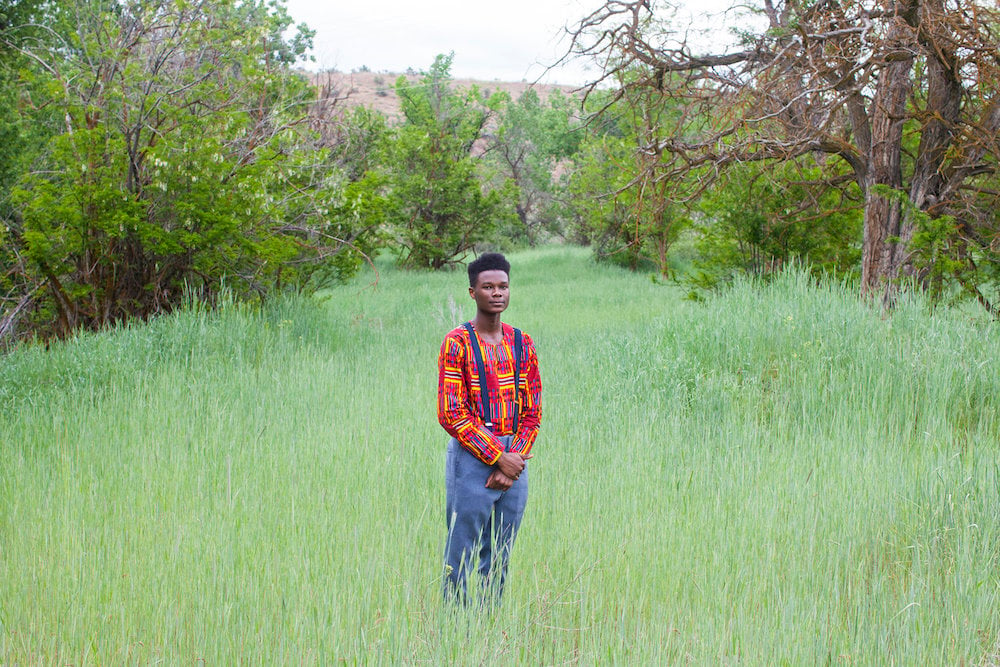
Smith’s work will be on view at an upcoming show in Los Angeles, opening April 11, at 1520 N. Cahuenga Boulevard from 6-9pm.
“My baby hasn’t sparked an existential crisis; she is meditation itself.” Beautiful piece from @evianahartman on motherhood at 40
Remembering the Thomas Guide

For anyone who loves maps, history, or the history of maps, Airtalk did a segment this week on the beloved Thomas Guide.
During the year I spent in LA in 2004, I have distinct memories of frantically flipping from page to page in the Thomas Guide as co-pilot. You had to memorize the page numbers of the areas you frequented because they were not always in order (a north/south jump would sometimes take you thirty pages off). After a few months of this, we had pages fall out of the spiral-bound guide that we were always shoving back in the book. It was really the only way to navigate the maze of sprawl here other than printing out turn-by-turn directions from Mapquest (which we also did).
Like a (wo)man without a country
The animated short “Your Black Friend,” based on the comic series by Ben Passmore, is a humorous and heartbreaking look at a very real topic. The film was temporarily removed from Facebook due to alt-right trolls earlier this year.
A special hardcover collection of Passmore’s comics series is out soon. It’s a vivid look at life and race in the backdrop of New Orleans.
(thanks Pete)
The charisma of lovable weirdo Jeff Goldblum

Read this homage to Jeff Goldblum in its entirety (preferably out loud, with a close friend) and then re-watch The Big Chill.
Edward Norton (‘Grand Budapest Hotel,’ 2014; ‘Isle of Dogs,’ out in March): A friend of mine was on a flight and was seated next to Jeff. She was reading a book and became aware that Jeff seemed to be looking at what she was reading. She said hello, and he asked her if she was enjoying the book.Jeff Goldblum: It was some good book she was reading! [It was ‘The Private Lives of the Impressionists.’]
Norton: Jeff said, “I don’t know if this would interest you—and if not, of course no problem—but I’m very good at reading books aloud, and if you’d like I’d be happy to read it to you.” She said, “Sure.” She had about 90 pages left, and Jeff read her the rest of it out loud. She said his reading was excellent.
Jeff Goldblum: We got out of the plane, and her boyfriend, Evan Goldberg, who writes with Judd Apatow, contacted me and said, “Look, I’m going to propose to that girl that you sat next to. I’ve written her a poem that’s kind of the proposal. And I want to drive her over to your house and have you read it to her. Can we come over at 7:30 in the morning tomorrow?” “Sure!”
Evan Goldberg: We drove up to the Hollywood Hills in a limo for the proposal haiku.
Jeff Goldblum: I’m in my robe. Ding-dong! Evan goes, “Here, darling, Jeff has something to read to you.” I read, “Dearest angel…would you be my wife?” And there you go. They’re married.
He keeps up with posts tagged #JeffGoldblum on Instagram, pours orange juice over his corn flakes, and smells good. Of course I love the Parker Posey anecdote: partying with Carrie Fisher in the 90s, movie night and a private piano concert with Goldblum and Rosario Dawson. A must read.
Still Processing on location

Jenna Wortham and Wesley Morris take a field trip to see the new Obama portraits in DC in the latest episode of their stellar podcast Still Processing and it’s beautiful. Wortham and Morris address the controversy over Michelle’s portrait and delight in Barack’s and are brilliant as always.
A piece only a Vermonter could write
A guide to the proper usage of the word “dank.”
The protean adjective (or adverb if you want to slink dankly along) is now used for so much more than to merely describe things that are “unpleasantly moist.” In modern usage, dank can be used to pinpoint particular qualities in marijuana, beer, and internet humor, or as a general term of praise. If that sounds confusing, it can be.
On the history of PDFs and political subterfuge
“The history of our generation will probably be in PDF form.”
(via Corrina)
Van Morrison and the Boston counterculture in 1968

Van Morrison wrote his spare, stringed magnum opus Astral Weeks during his time among the late 60s LSD-fueled counterculture in Boston. Ryan H. Walsh’s new book Astral Weeks: A Secret History of 1968 covers the nine months Morrison spent in Cambridge, as well as a cast of characters both known and not. Among those orbiting Morrison were commune/cult leader Mel Lyman, members of the Velvet Underground, who played the Boston Tea Party club 15 times that year, and Carly Simon’s younger brother, Peter.
The common thread among the myriad personalities and communities profiled by Walsh is a yearning for transcendence and rebirth. These are also the central themes of Van Morrison’s “Astral Weeks.” Morrison’s route to the spiritual plane was through music, not drugs. (A notorious drunk during his time in Boston, he is said to have eschewed dope after “burning [his] brain on hash” when he was younger.) The singer seems to have been guided by his subconscious in creating “Astral Weeks.” Some of the songs emerged from dreams and reveries. Morrison was a student of the occult who believed in automatic writing.
From stories of gigs on Cape Cod where Morrison and his band improvised what became “Moondance,” to him quietly crooning about Cambridgeport “like he’s talking about a misty hobbit village,” Walsh’s book seems to give context for Boston being more culturally significant within the late 60s era than most people give it credit for.
(Image of Van Morrison performing at Spring Sing on Boston Common in 1968 via WBUR.)
Rewriting the NY Times Obit section
The paper of record somehow failed to note the passing of Diane Arbus, Nella Larsen, Sylvia Plath, and twelve other equally influential women over their 167 years of publication. They updated this for International Women’s Day in their series Overlooked.
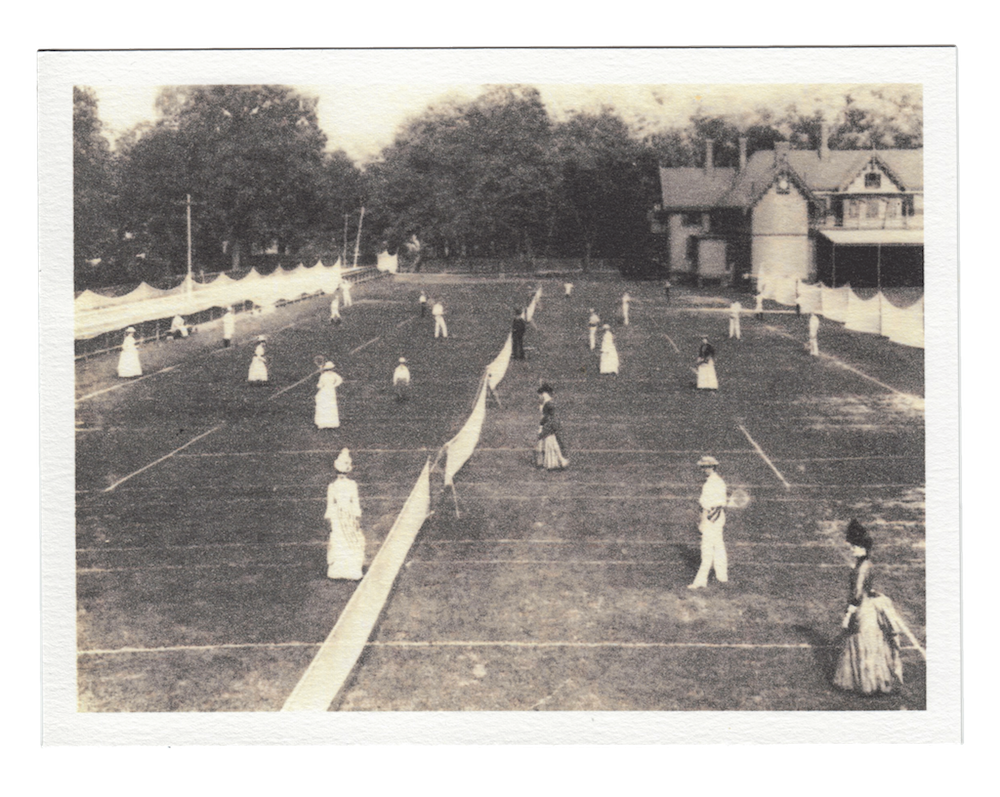
The whole package is worth a read, but I love the story of Mary Ewing Outerbridge who (probably) brought tennis to the US.
Outerbridge explained that the items were for a game called Sphairistiké, which is Greek for “playing at ball.” She had seen British Army officers engaged in a match during a vacation in Bermuda and was entranced by the graceful strokes and fluid motions. She told the agents she was taking the gear back home, to Staten Island, to teach her friends and family to play.
Also noteworthy: Jane Eyre author Charlotte Brontë.
While Brontë did not get an obituary in The New York Times, her husband, who died 51 years later, did. The article was just five lines long, and the headline said it all: “Charlotte Bronte’s Husband Dead.”
After 40 years, an Indian architect wins the Pritzker

Balkrishna Doshi is the first-ever Indian to receive the Pritzker Architecture Prize. The 90-year-old modernist architect studied under Le Corbusier in Paris and later worked together in India, and collaborated with Louis Kahn, but Doshi was the one to adapt their work to the culture, climate, and topography in India.

Doshi was a vital, though largely unheralded partner in creating India’s meccas for modern architecture. He translated Le Corbusier and Khan’s plans to Indian construction standards and found ways to weave pre-fab materials with artisan-made elements.
“A lot has been said and continues to be said about the shadow of Le Corbusier and Louis Kahn on the city and the country at large, but it was Doshi who grounded their ideas in the soil of India and turned them into something entirely new,” explains Avinash Rajagopal, editor-in-chief of Metropolis magazine.
Don’t move to Los Angeles
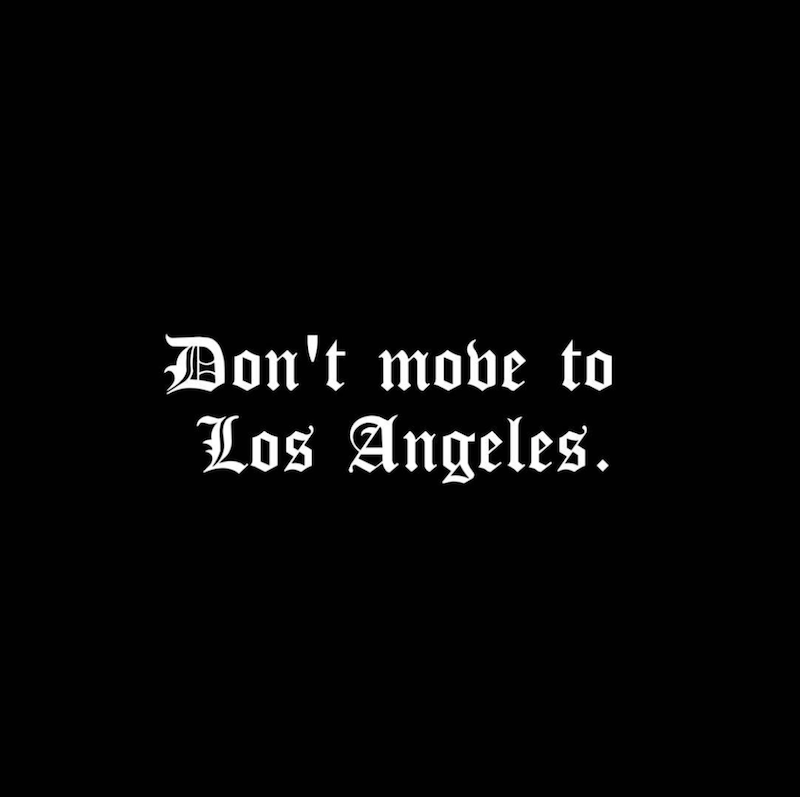
As a nice coda to yesterday’s post on gentrification in Los Angeles, the adroit Ann Friedman tells us how not to ruin her adopted city.
I like to think I’m one of the good transplants. (Don’t we all?) I came to California seven years ago when most New Yorkers were still turning up their noses at this city. I had a local job — not a work-remote situation. I befriended my neighbors. I patronized burrito joints that were not endorsed by Anthony Bourdain. I got a public library card. I learned the bus routes near my house. I made sure to vote in local elections.
Image via Rafa Esparza, who asks “What can citizenship outside of colonization and more in tune with cultural stewardship look like?”
This is the question for L.A.’s economically privileged new arrivals: How do you help care for the city that drew you in, rather than allow your presence to steamroll its culture?
Also insert “New York” and “San Francisco,” above.
Privacy at the margins

Privacy and privilege go hand in hand. This collection of scholarly articles in The International Journal of Communication edited by Dr. Alice Marwick and danah boyd takes us to Appalachia, India, Azerbaijan, and among Aboriginal communities. The nine articles are a deep dive into surveillance, coercion, and consent among those typically marginalized.
For many people, privacy is not simply the ability to restrict access to information, but the ability to strategically control a social situation by influencing what information is available to others, how this information is interpreted, and how it will spread. Needless to say, networked technology complicates these dynamics, to the point where most people find themselves constantly negotiating between disclosure, concealment, and connection.
The stark reality is that achieving privacy is especially difficult for those who are marginalized in other areas of life. Parents argue that they have the right to surveil their children “for safety reasons.” Activists who challenge repressive regimes are regularly monitored by state actors. And poor people find themselves forced to provide information in return for basic services. Meanwhile, privacy is increasingly important as data-hungry algorithmic systems are introduced into every part of society, gobbling up data about people and their practices to feed decision-making systems in sectors as varied as criminal justice, advertising, transportation, and news delivery. The privilege to “opt out” of these data-oriented systems is increasingly unattainable.
“LA is the best”
If you’re back east enjoying a snow day today, might I recommend cozying up with the brilliant Ingrid Goes West? Documentary of the year 2017, IMHO.
(Yes, that is Ice Cube, Jr.)
Spike Jonze is very good at making ads
Huh, weird. Spike Jonze made a video of me in my living room last night.
I’m fully here for FKA Twigs being the face of dancing your way out of depression.
F*** hipsters

My former colleagues Andrew Romano and Garance Franke-Ruta took a look at recent protests led by Defend Boyle Heights and the larger radical anti-gentrification movement they’ve inspired. Coffee shops are being targeted and galleries shutting down from harassment on the east side of Los Angeles.
Gentrification isn’t new, nor is anti-gentrification activism. So why are these groups taking to the street now?
Millennials are, simply put, “facing the scariest financial future of any generation since the Great Depression,” as HuffPost’s Michael Hobbes recently put it. They’ve taken on at least 300 percent more student debt than their parents did. They’re about half as likely to own a home as young adults were in 1975. One in five is living in poverty. Based on current trends, many of them won’t be able to retire until they’re 75. Jobs have become gigs; college is exorbitant, starting salaries are paltry the social safety net is shredded.
And all of these trends are especially acute among the poorer, nonwhite millennials who tend to live in major cities. Between 1979 and 2014, for instance, the poverty rate among young high school-only graduates more than tripled, to 22 percent, and roughly 70 percent of black families and 71 percent of Latino families don’t have enough money saved to cover three months of living expenses.
Frank Ocean interviews statistics rapper Timmy T

Frank Ocean interviews Timothée Chalamet and it’s brilliant.
FO The time period of 20th Century Women seems close to Call Me By Your Name, that ’80s time period. Did you get into these past eras of fashion and shit when you were doing the film?
TC Absolutely. I’m a total “nostalgist” and Call Me By Your Name’s director, Luca, grew up in that time period. In fact, the book is set in ‘88 and he changed it to ‘83 because he said that was the year in your life you can hear music from. In the movie, there’s Talking Heads, The Psychedelic Furs, or just the Bach or Beethoven—those are all songs from Luca’s youth, what it was like for him in Italy in the ’80s. Also, in 1988, the AIDS crisis had already hit and that was part of the reasoning for making [the film] a little bit earlier too, so it wasn’t as intense, and could be a little more utopic. What a tragedy for movies now that if you want to be contemporary, phones have to be involved, with texting and FaceTime. I don’t know if [the characters in] Call Me By Your Name would ever have that relationship if there was passive-aggressive commenting and “likes.” They actually had to talk, figure each other out, and struggle with their emotions.
I believe the children are our future
Watching the teenagers from Parkland, Florida instigate change and challenge leadership has been inspiring, to say the least. If anything, it’s a reminder that while it’s probably too late for our generation to make any real change, the kids these days are on it.
Tim Kreider’s op-ed Go Ahead, Millennials, Destroy Us encourages this new crop of activists. (thx Jessa)
My message, as an aging Gen X-er to millennials and those coming after them, is: Go get us. Take us down — all those cringing provincials who still think climate change is a hoax, that being transgender is a fad or that “socialism” means purges and re-education camps. Rid the world of all our outmoded opinions, vestigial prejudices and rotten institutions. Gender roles as disfiguring as foot-binding, the moribund and vampiric two-party system, the savage theology of capitalism — rip it all to the ground. I for one can’t wait till we’re gone. I just wish I could live to see the world without us.
Emma Gray’s timely book The Girl’s Guide to the Resistance: A Feminist Handbook on Fighting for Good is relevant for kids of all genders who want to get involved (though soon enough, they’ll be writing the books explaining change to us).
In this week’s series from The Cut, How To Raise a Boy Michael Kimmel says that instead of shaming bad behavior, we should focus on positive growth.
Fathers: If you want a story to tell your sons, tell that story, the time you did the wrong thing because you were scared. That’s the story we grown men must tell our sons. We must tell them for their sake, because it can help them acknowledge the ways that they, too, may feel pulled between their own values and those of others. But we must also tell them for our own sake, so that we can finally acknowledge the damage done to us, done to our hearts, our souls, by the demands of trying to deny our humanity and be real men.
Anthony McCall’s large-scale sculpture, cinema, drawing objects

Pioneer Works in Red Hook, Brooklyn is currently showing six large-scale pieces by local artist Anthony McCall. The main hall of the massive warehouse space is blacked out and filled with haze for the show of his Solid Light Works series, which he began work on in 1973. The pieces require thirty feet of clearance from the floor to ceiling for the vertical and horizontal cones of light.

McCall regards these works as occupying a place somewhere between sculpture, cinema, and drawing: sculpture because the projected volumes must be occupied and explored by a moving spectator; cinema because these large-scale objects are not static, but structured to progressively shift and change over time; and drawing, because the genesis of each installation is a two-dimensional line-drawing.
Solid Light Works explore the intersections of light, movement, drawing, and space that form evanescent and ever changing three-dimensional forms that exist not only as “objects” in space but also as environments to be experienced.
In anticipation of the show’s closing, Pioneer Works will stay open all night on Saturday. I hope someone’s sending a street style photographer to capture the crowd.
Katja Blichfeld’s personal reinvention

We should all be talking more about High Maintenance, a show sort of about weed but really about the human condition.
Last season’s episode “Grandpa” is unlike anything else I’ve seen on TV, but do yourself a favor and start with their original webisodes and work your way up to the current season on HBO. ”Rachel” is also not to be missed (Dan Stevens plus Rachel Comey, swoon).
Emily Gould’s recent profile on co-creator Katja Blichfeld gives a look at half of the real-life (former) couple behind the show. I particularly like the story of her career trajectory.
Before she was known for High Maintenance, Blichfeld was a casting director, a job at which she was very successful (she won an Emmy for her work on 30 Rock) and at which she arrived via an indirect path. Born in Long Beach, California, to Danish parents, she grew up attending Evangelical Christian schools, where she was taught that much of pop culture was the devil’s doing. “Like I couldn’t watch The Smurfs,” she explains, “because of witchcraft and sorcery.” She spent a couple of semesters at Long Beach City College, dropped out, moved to Chicago, worked in admin at a university, and then, in 2004, followed a relationship that had begun on Friendster to New York. “We were watching a lot of movies together, and the way that I would talk about movies was always very actor-centric. And I remember this person saying, ‘You should be a casting director.’” Blichfeld decided she’d try to get an internship. She made a list of people she wanted to work for, topped with Jennifer McNamara, who had just won a bunch of awards for her work on Sex and the City: “She, being a casting director — you know, very good at seeing potential — saw it in me, lucky me, and took me on.
The life-imitates-art-imitates-life aspect of Blichfeld’s breakup and the show really gets me, too.
On the psychology (and business) of color
Leatrice Eiseman, Pantone Color Institute’s executive director, teaches an annual class on trend forecasting and the psychology of color. She joined Pantone after publishing her 1983 book “Alive With Color,” and she created the color clock concept.
Eiseman believes that our reaction to colors “goes beyond the psychological into the physiological” and that colors carry inherent messages that all humans innately understand — the whispers of that “ancient wisdom.” She doesn’t deny the important influence of memory and social factors on color perception, but often, she says, “our response is involuntary, and we simply have no control over it.”
Last October, Eiseman published her 10th book, “The Complete Color Harmony, Pantone Edition,” her boldest statement yet on the psychology of color — and one that might rightly be displayed in the self-help section. Consider a chapter titled, “Personal Colors: What Do They Say About You?” which offers a kind of chromatic horoscope that locates truths not in the cosmos but in the spectrum of visible light.
If you’ve ever wondered how the Pantone Color of The Year comes to be, Bruce Falconer’s exploration of the business of color is the place to start.
N.B. I’m pretty sure lilac will be the next millennial pink, but I’m no expert.
The data behind Hollywood’s sexism
Dr. Stacy Smith, one of the creators of the inclusion rider, spoke at TEDWomen in 2016 about the epidemic of invisibility in Hollywood. She uses hard data to break down how women and minorities are not just underrepresented in film, they’re erased, and just how pernicious this is for all of us.
Storytelling is so important. Stories tell us what societies value, they offer us lessons, they share and preserve our history. Stories are amazing. But stories don’t give everyone the same opportunity to appear within them, particularly not stories compartmentalized in the form of American movies.
Dr. Smith and her team have done more than 30 investigations over the past ten years on diversity in entertainment. Follow the Annenberg Inclusion Initiative at @inclusionists.
Guest editing this week: Chrysanthe Tenentes
[Hello gang. I am off this week and am very pleased that my pal Chrysanthe Tenentes will be taking over while I’m gone. We haven’t caught up in awhile, so I’m eager to learn what she’s thinking about these days and what she’s been working on. Welcome, Chrysanthe! And I’ll see the rest of you rascals next week. -jason]
Longtime reader, first time guest editor here…I’ve been mostly behind the scenes working on content strategy and other editorial projects the past few years but you may know me from Brooklyn Based, where I was co-founder, Foursquare, where I was an early hire, or The Shed story salon, which I run with friends in Brooklyn. I’m currently on the west coast, consulting for a few clients and about to launch LA IS OK. I’m on Twitter and most things as eqx1979, which is a reference to the alternative radio station I listened to in high school (heart you forever WEQX) and that Smashing Pumpkins song that I apparently liked enough to use in my ICQ screen name that then became all my screen names.
But enough about me, let’s get back to the links! I’m very much looking forward to spending the week with you all.
Miyazaki’s layouts for Howl’s Moving Castle
Howl’s Moving Castle is my favorite Miyazaki movie, and maybe my favorite movie, outright; I wrote a little bit about why in this essay.
Every frame of the film is magnificent, as these layouts help to show (I’m only including one, from one of my favorite scenes, plus the finished version; there are more at the Ghibli Collector Tumblr).
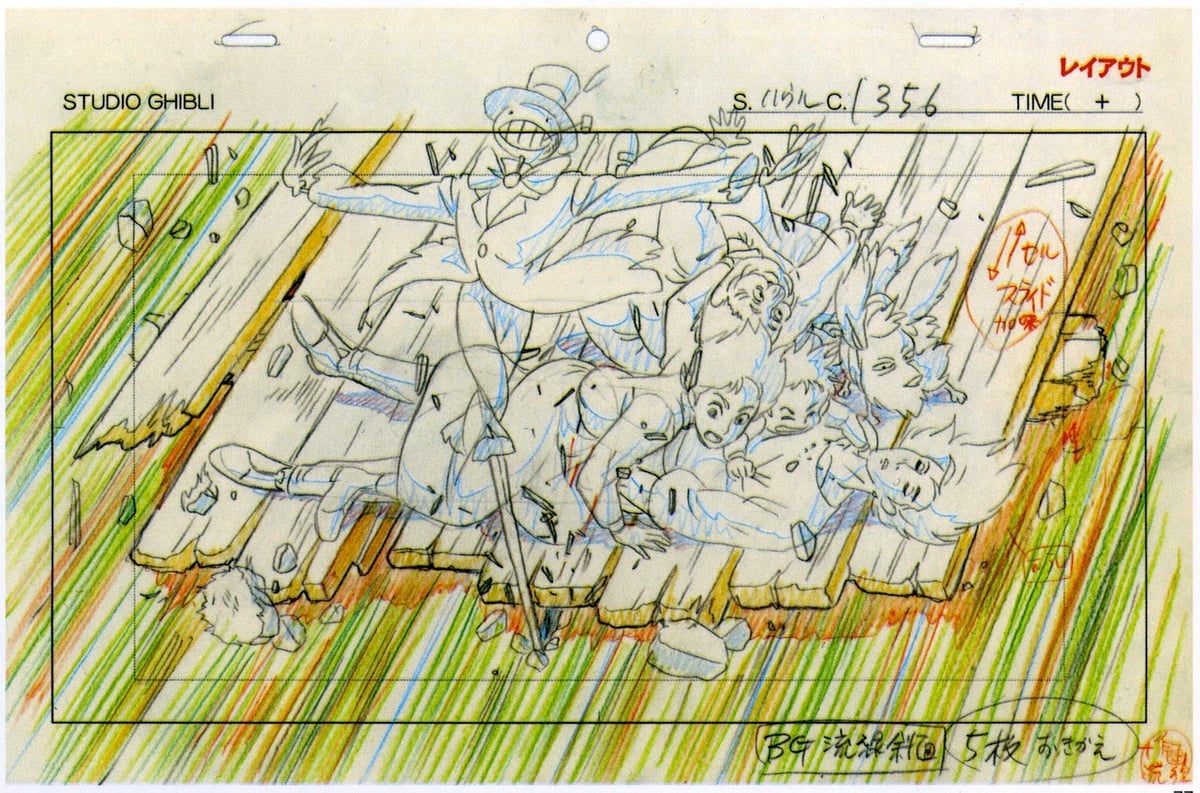

(Via Thomas Houston.)
A week without plastic

The Guardian asked four writers to try to minimize their use of plastic and keep a diary of how much they used over a week. To no one’s surprise, it’s difficult to avoid plastic altogether, but I suspect anyone would be stunned at just how much of it there is.
Before going to bed I wash my face with micellar water (which comes in a plastic bottle), use an interdental tooth brush (plastic), and take out my monthly contacts (plastic). I’ve barely done anything today, but the pile in the corner of the kitchen is getting bigger. On day two, the plastic onslaught continues; now I’m looking for it, I see it everywhere. Thanks to a cold, I go through multiple plastic-wrapped packets of tissues. A pizza delivery arrives with unnecessary plastic cutlery and a plastic-wrapped chocolate bar. I get my (acrylic) nails done, receive some clothes from Asos which come in plastic packaging, as does the ink for my printer…
Five days in and I’m amazed to realise how much I have accrued, from the Amazon delivery which arrives wrapped in bubbles and film, to the balloons we blow up for my flatmate’s birthday (latex, not plastic, but very much single use). The morning after her party, the flat is full of plastic cups, straws and bottles; soon thrown away in several plastic bin bags. I need some help; I speak to Andrew Pankhurst, a consumer campaigns manager from Zero Waste Scotland. He takes a look at my diary and has a few tips, from sharing printer cartridges with flatmates to putting a recycling bin in the bathroom. Could I possibly remove plastic from my everyday life?
This reminds me of something materials scientist Deb Chachra told me once: that as petroleum gets harder and harder for us to find economically, we might start to worry less about peak gasoline than we do about peak plastic.
Hacking the lottery
Jerry and Marge Selbee were a semi-retired couple in rural Michigan who ran a convenience store. Among their biggest sellers were lottery tickets. One day, Jerry realized that if you only played on certain “roll-down” days (when a four-out-of-six winner would get part of a five-out-of-six prize, and so on), the odds weren’t just better for players; they were positive. You just had to buy a lot of tickets.
Lottery terminals in convenience stores could print only 10 slips of paper at a time, with up to 10 lines of numbers on each slip (at $1 per line), which meant that if you wanted to bet $100,000 on Winfall, you had to stand at a machine for hours upon hours, waiting for the machine to print 10,000 tickets. Code in the purchase. Push the “Print” button. Wait at least a full minute for the 10 slips to emerge. Code in the next purchase. Hit “Print.” Wait again. Jerry and Marge knew all the convenience store owners in town, so no one gave them a hard time when they showed up in the morning to print tickets literally all day. If customers wondered why the unassuming couple had suddenly developed an obsession with gambling, they didn’t ask. Sometimes the tickets jammed, or the cartridges ran out of ink. “You just have to set there,” Jerry said.
The Selbees stacked their tickets in piles of $5,000, rubber-banded them into bundles and then, after a drawing, convened in their living room in front of the TV, sorting through tens or even hundreds of thousands of tickets, separating them into piles according to their value (zero correct numbers, two, three, four, five). Once they counted all the tickets, they counted them again, just to make sure they hadn’t missed anything. If Jerry had the remote, they’d watch golf or the History Channel, and if Marge had it, “House Hunters” on HGTV. “It looked extremely tedious and boring, but they didn’t view it that way,” recalled their daughter Dawn. “They trained their minds. Literally, they’d pick one up, look at it, put it down. Pick one up, put it down.” Dawn tried to help but couldn’t keep pace; for each ticket she completed, Jerry or Marge did 10.
Naturally, of course, the couple hits trouble when they shift their game to Massachusetts and bumps up against a group of MIT students who have the same idea. Hijinks ensue.
The history of “I am,” “to be,” “it was”
Arika Okrent is one of my favorite writers. She’s a linguist who specializes in breaking down experientially rich but conceptually knotty problems in language for a lay audience. For the last few years she’s been writing for Mental Floss — see “The Evolution of ‘Two’,” this short essay on Plains Indian Sign Language, or especially her series of YouTube videos, of which the bit on irregular verbs up top is one.
Anyways, now she’s contributing to Curiosity, and one of her first essays is on the history and structure of that most irregular and polysemic of English verbs, “to be.”
Most verbs stay basically the same in different grammatical roles. “Walk” looks like “walks” and “walked.” But the word “be” looks nothing like the word “am,” which looks nothing like the word “were.” This unusual circumstance came to be over thousands of years and can be traced back to an ancient ancestor of English.
That ancestor had three different verbs that gave rise to the different forms. “Am” and “is” go back to one of them. “Be,” “being,” and “been” go back to another verb meaning “to become” or “grow.” “Was” and “were” go back to yet another verb meaning “remain” or “stay.” Over thousands of years, these concepts and forms coalesced into a verb with a single identity, but hundreds of specific meanings.
The sounds of an Antarctic glacier
Peter Neff is part of a team drilling ice cores from glaciers in Antarctica to look at how the climate has changed. But after they’ve done their work, they have a little fun dropping chunks of ice down the bore holes to make really cool noises (sound on, headphones recommended).
Sound ON
— Peter Neff (@peter_neff) February 28, 2018
When #science is done, it’s fun to drop ice down a 90 m deep borehole in an #Antarctic #glacier. So satisfying when it hits the bottom.
Happy hump day. pic.twitter.com/dQtLPWQi7T
Oh, that *peeewwww* as it hits the bottom! See also the wonderful sounds of black ice skating, an incredible photo of the black ice covering an Antarctic lake, and “Whumph”: the sound of settling Antarctic snow.
Is Goya’s Saturn Devouring His Son the most disturbing painting?
In the latest installment of Nerdwriter, Evan Puschak explains why Francisco Goya’s painting Saturn Devouring His Son is so disturbing, not only from the standpoint of the subject matter but also the circumstances surrounding its creation.
I am especially fond of Art History Nerdwriter because the first video of his I ever watched was on Jacques-Louis David’s The Death of Socrates. I’ve been a fan ever since.
How ants build bridges using very simple rules
Check out these army ants building an ant bridge across a gap that suddenly widens:
Army ants have tiny brains and no one’s in charge. So how do they organize themselves into building bridges? They rely on their strength in numbers and simple rules.
To see how this unfolds, take the perspective of an ant on the march. When it comes to a gap in its path, it slows down. The rest of the colony, still barreling along at 12 centimeters per second, comes trampling over its back. At this point, two simple rules kick in.
The first tells the ant that when it feels other ants walking on its back, it should freeze. “As long as someone walks over you, you stay put,” Garnier said.
This same process repeats in the other ants: They step over the first ant, but — uh-oh — the gap is still there, so the next ant in line slows, gets trampled and freezes in place. In this way, the ants build a bridge long enough to span whatever gap is in front of them. The trailing ants in the colony then walk over it.
See also How many stupid things become smart together.
(via fairly interesting)
The area of a circle. I love this…showing the geometric representations of abstract math formulas can greatly improve understanding.
Flowers freezing, flowers burning, flowers blooming
In his short film Dance Dance, director Thomas Blanchard represents all four seasons by showing flowers blooming, submerged in water that freezes over, burning, and shrouded in clouds of colorful inks. I could have watched the flowers freezing over part for many more minutes. (via colossal)




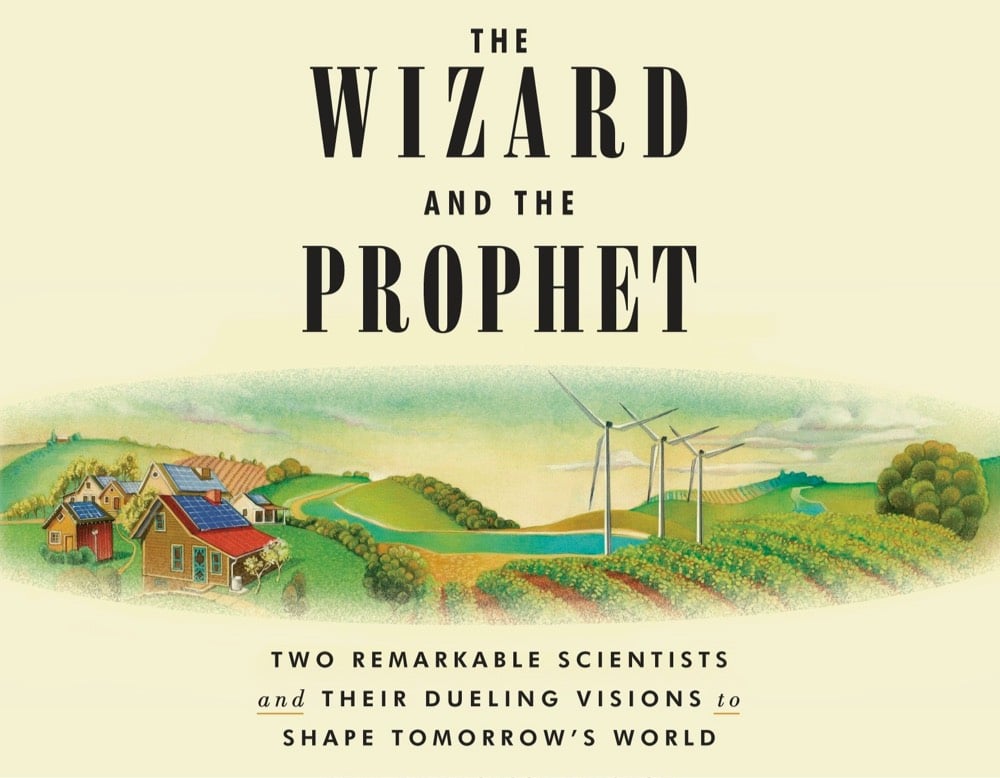
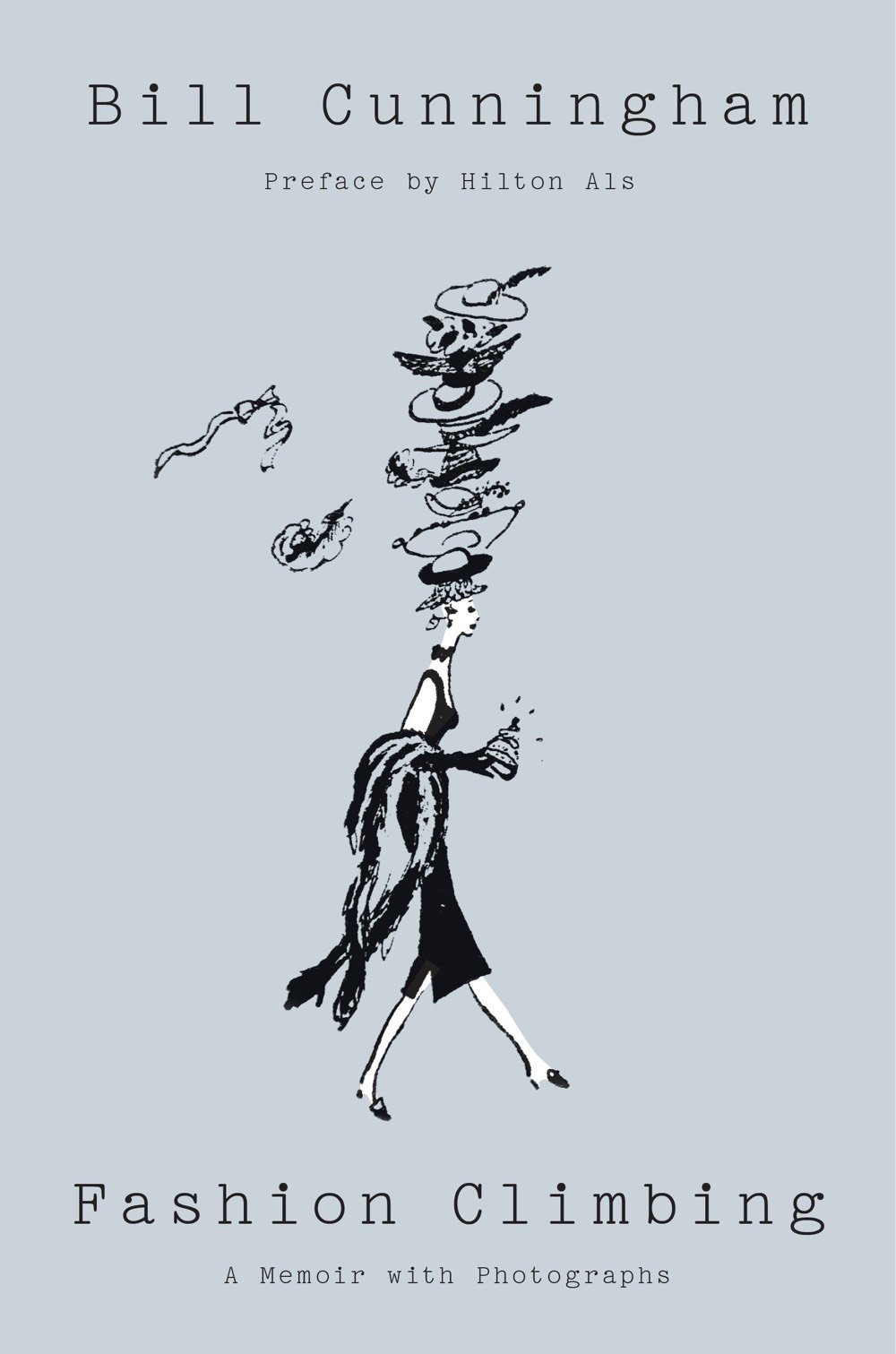
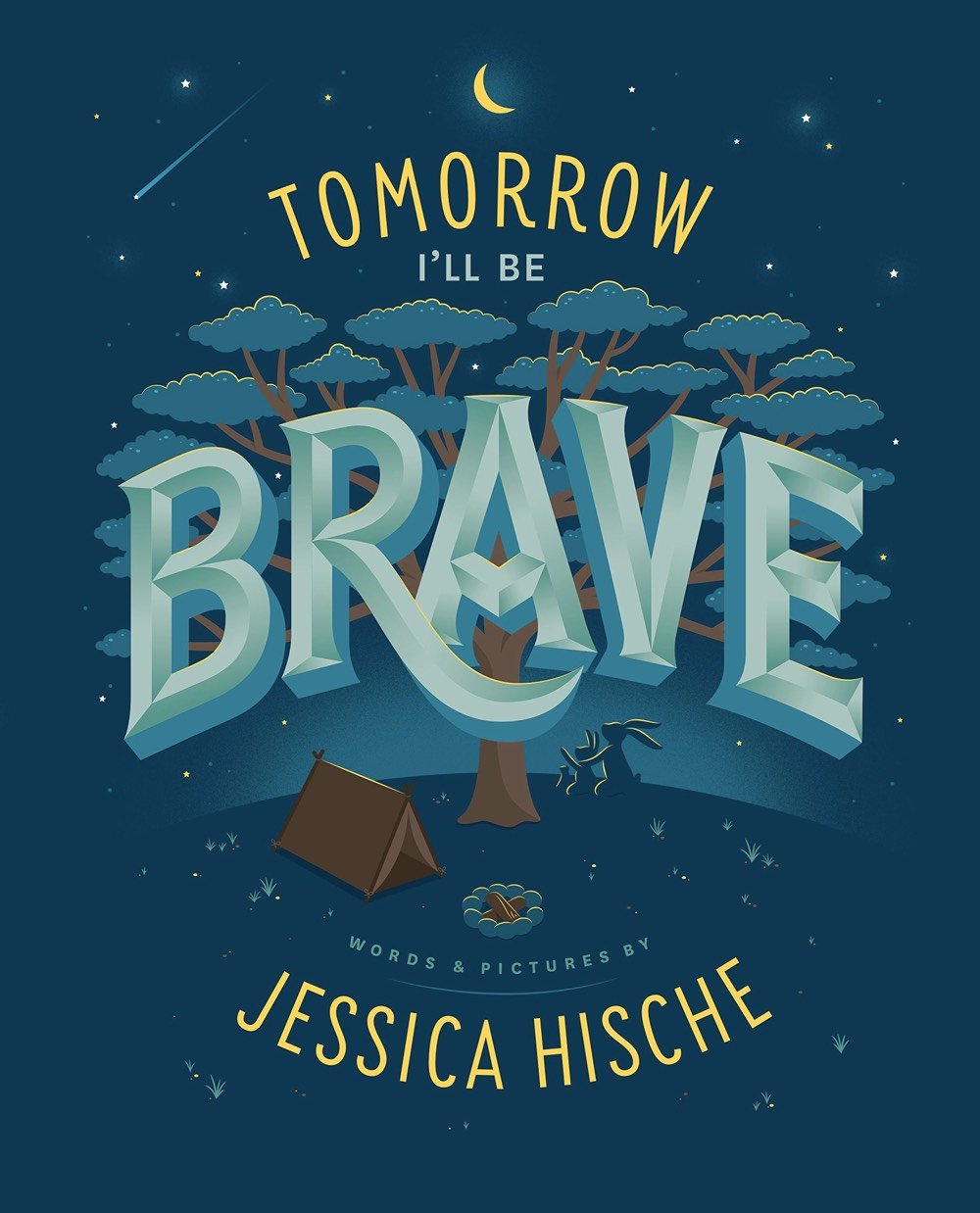
Stay Connected